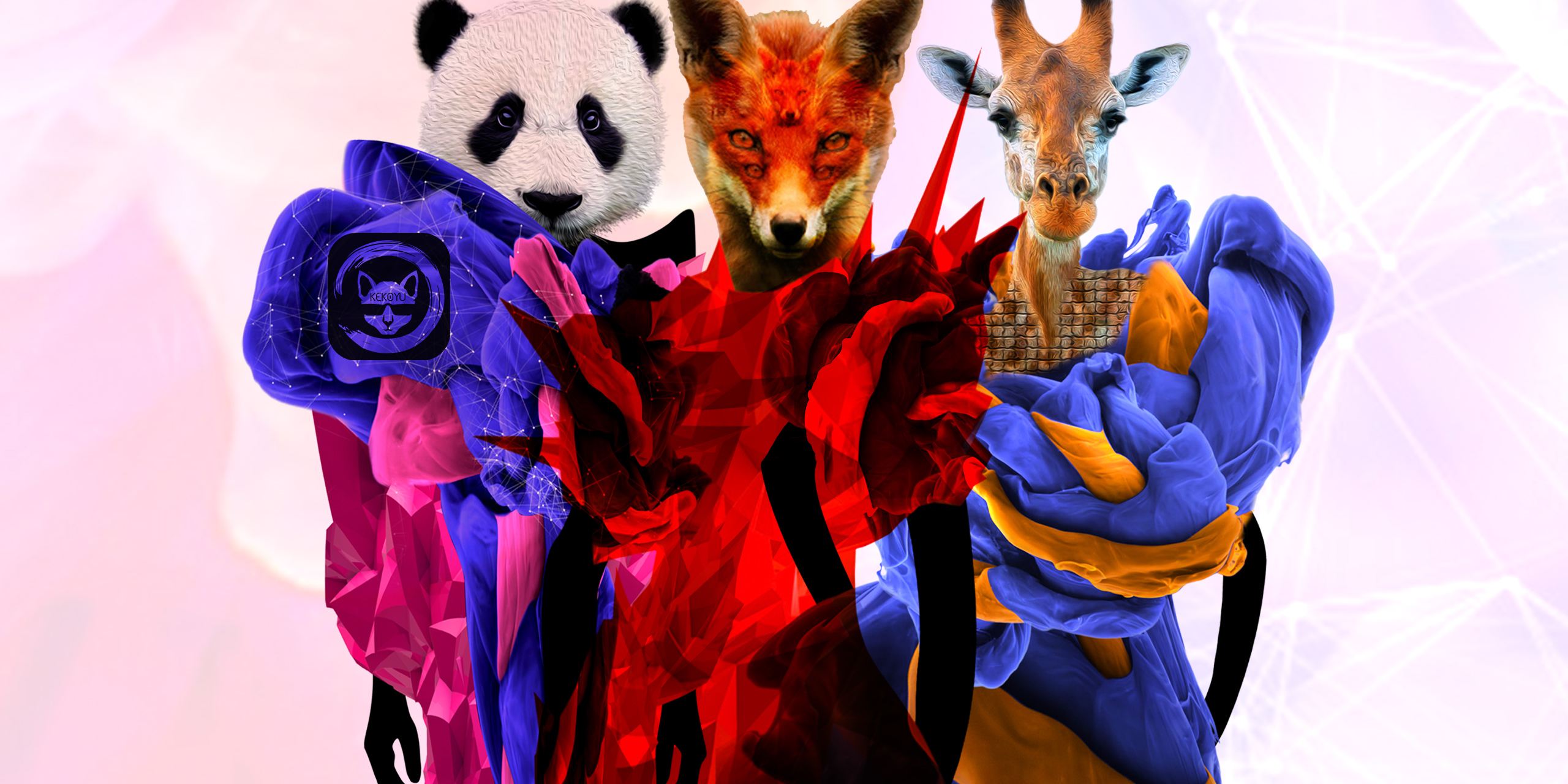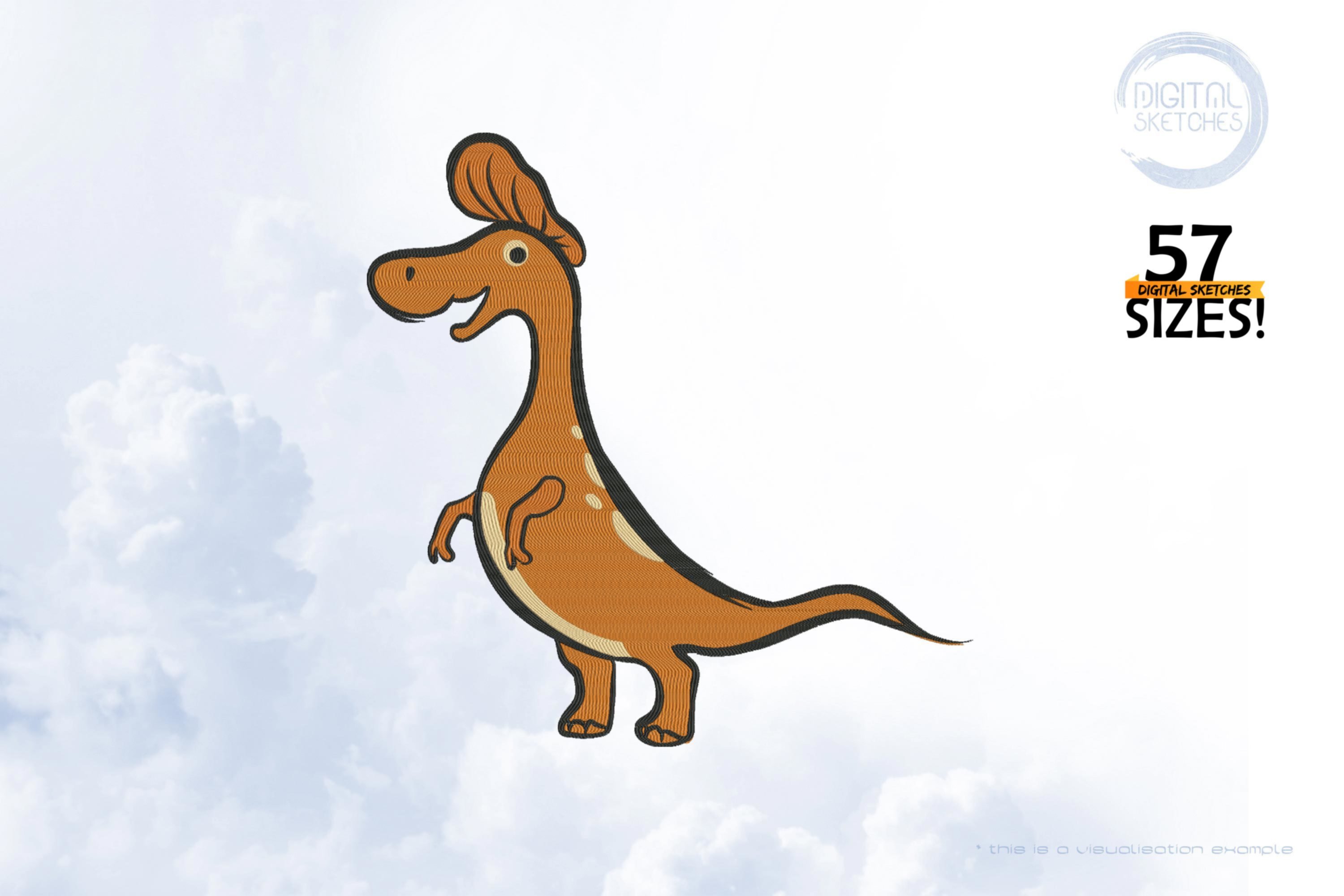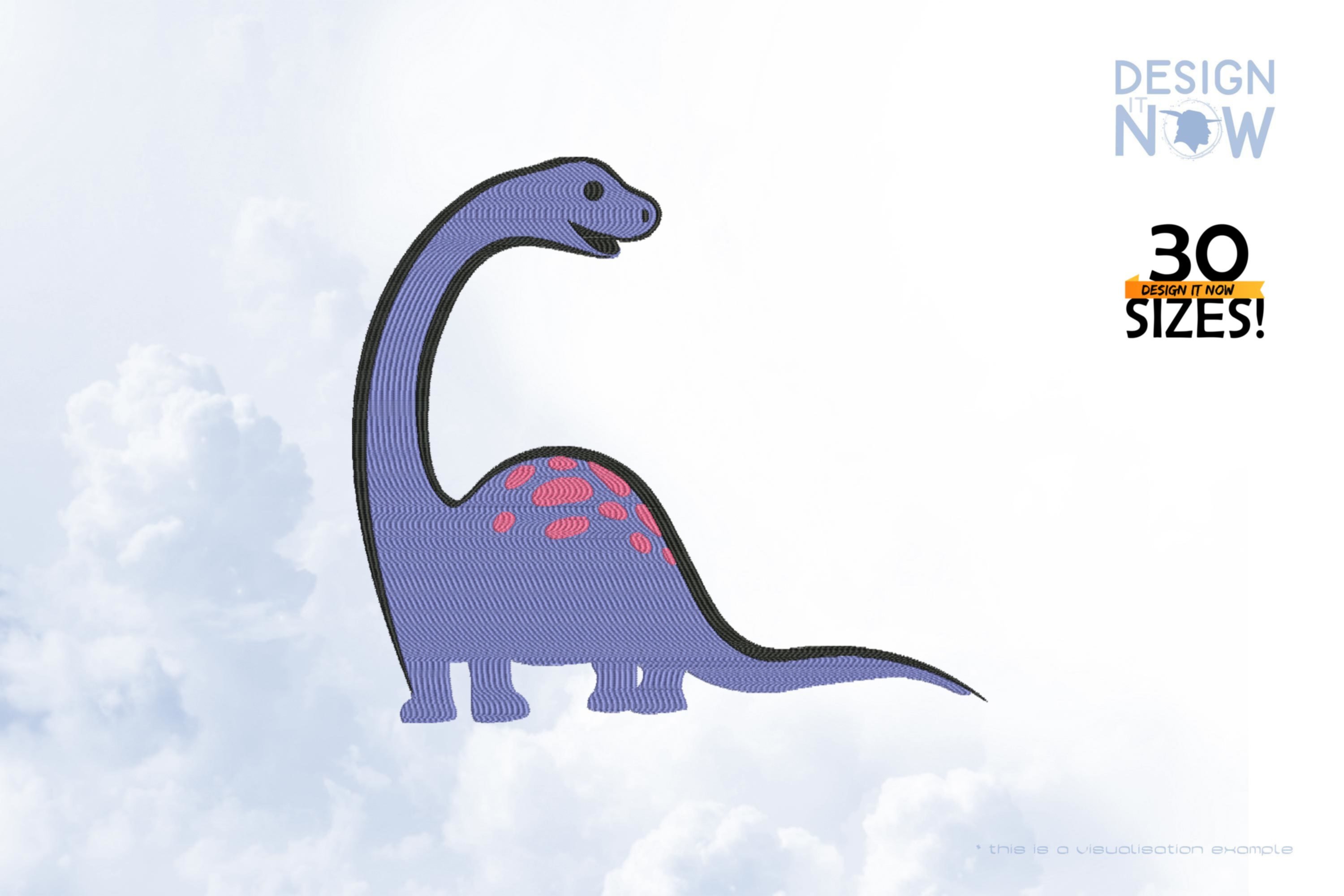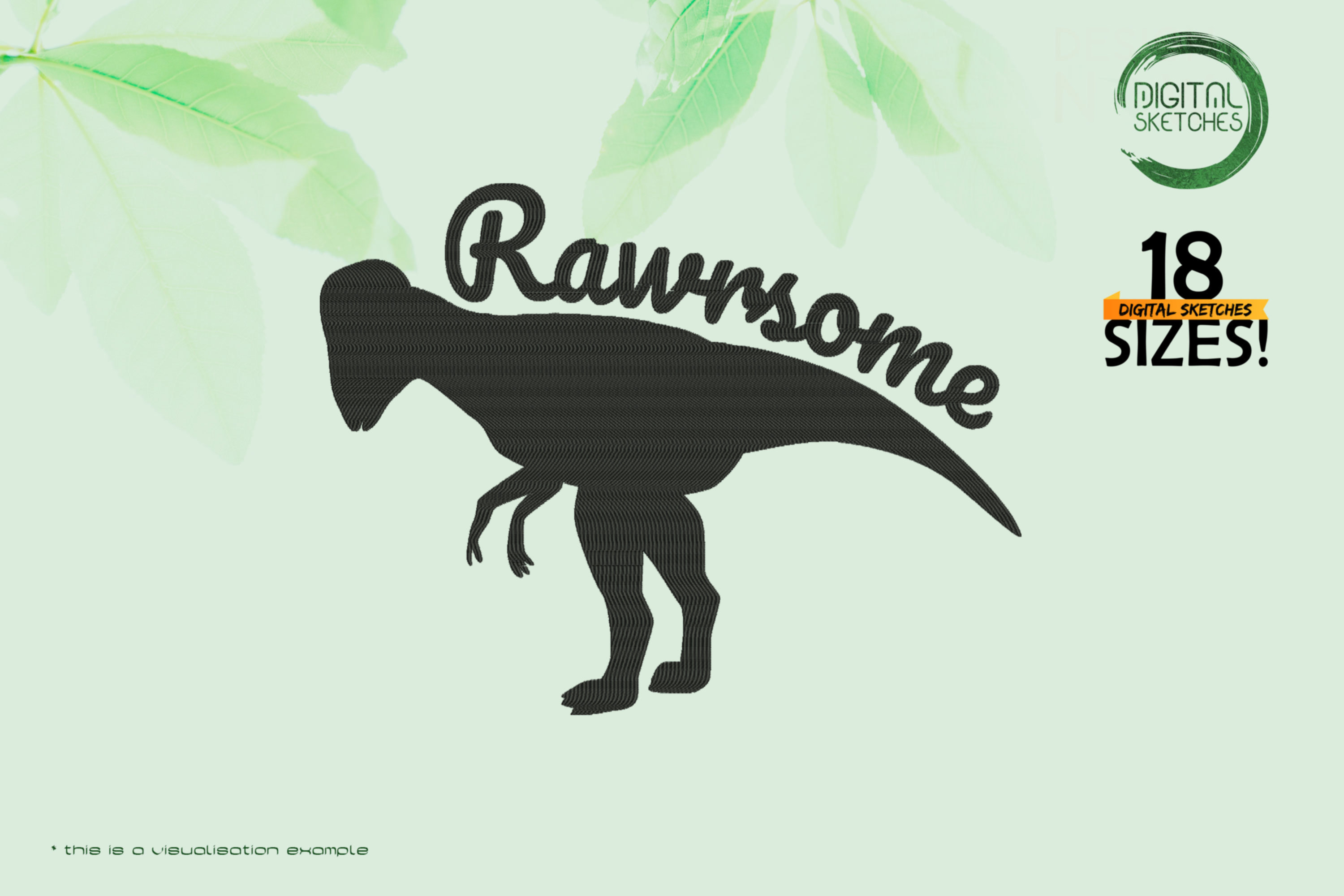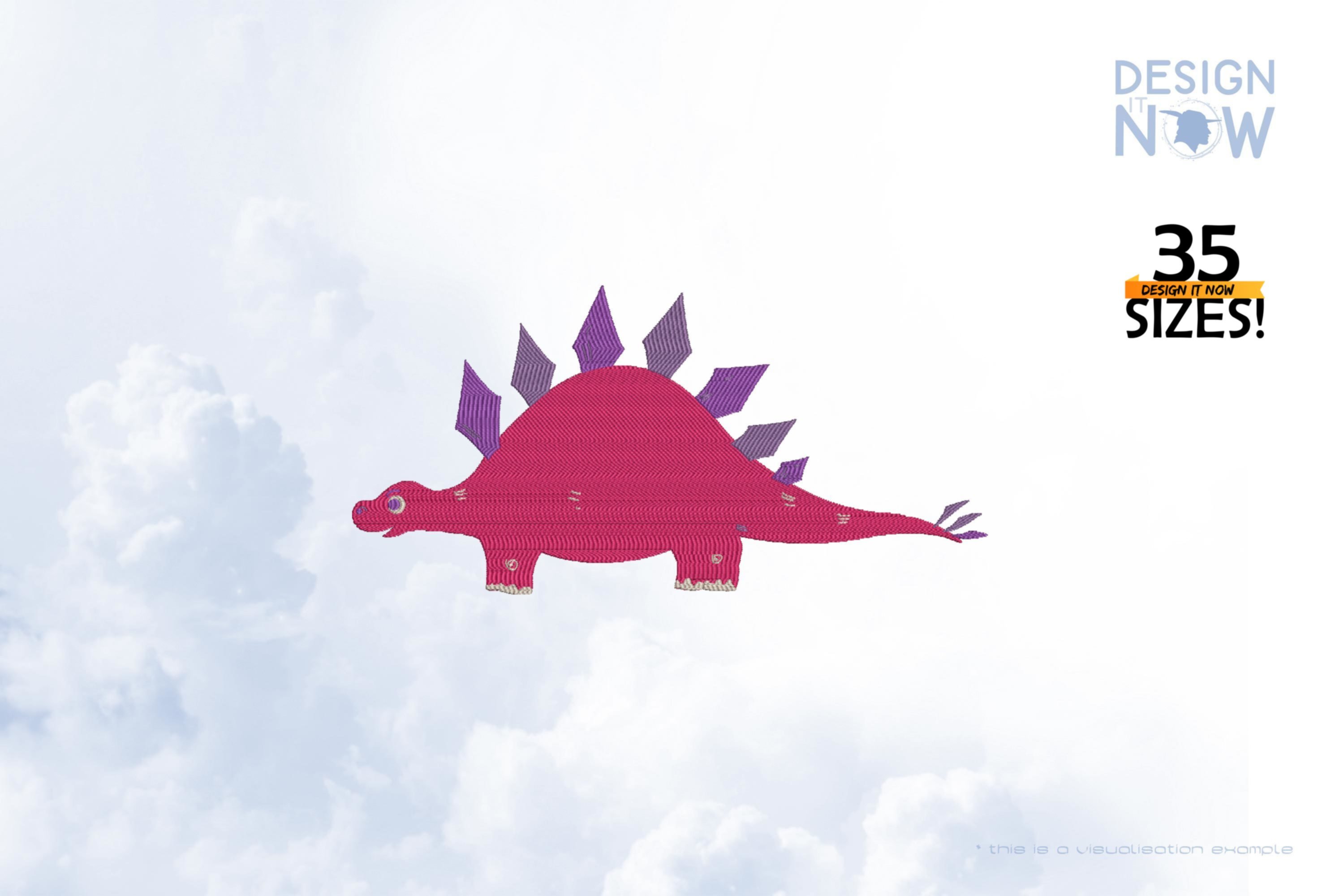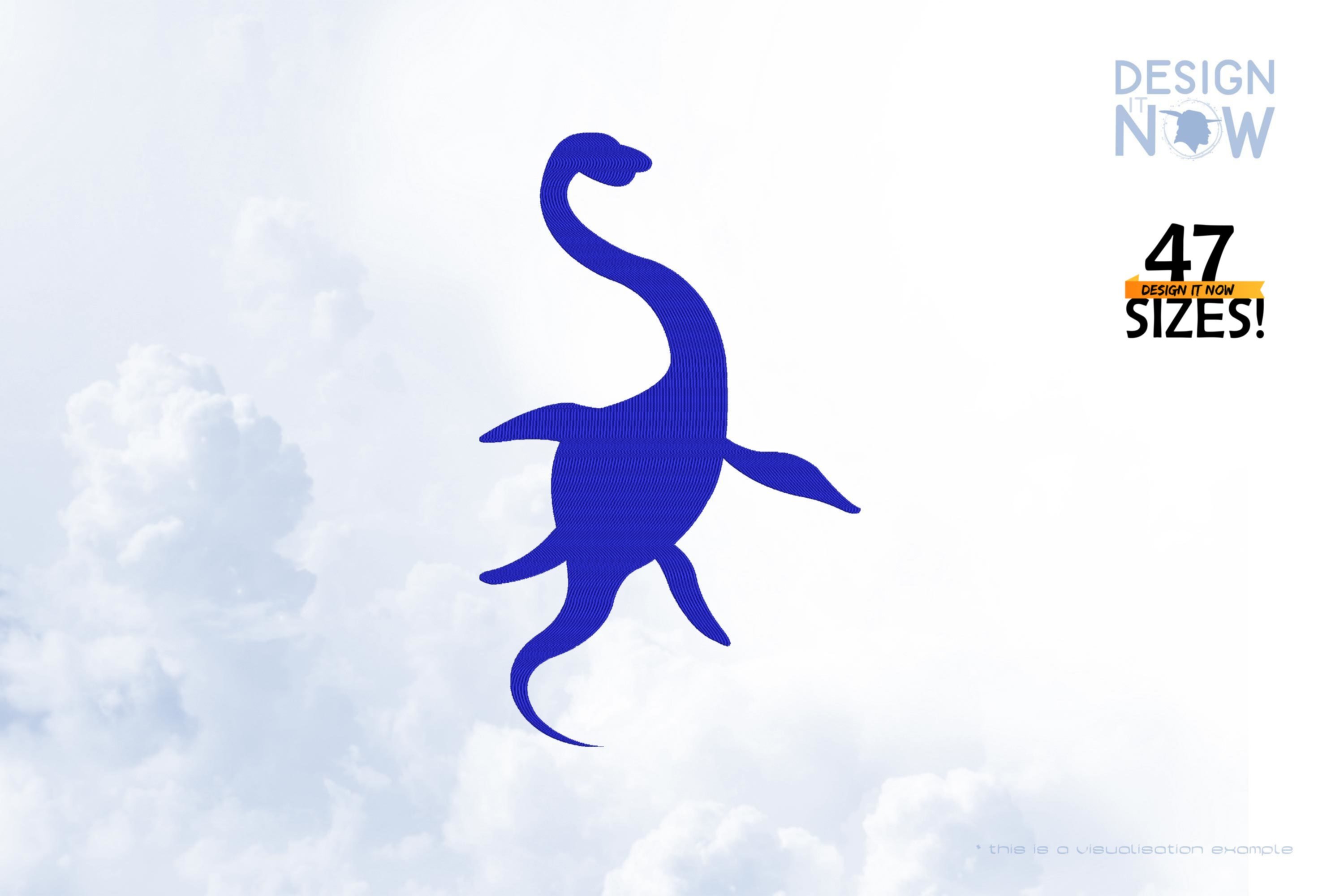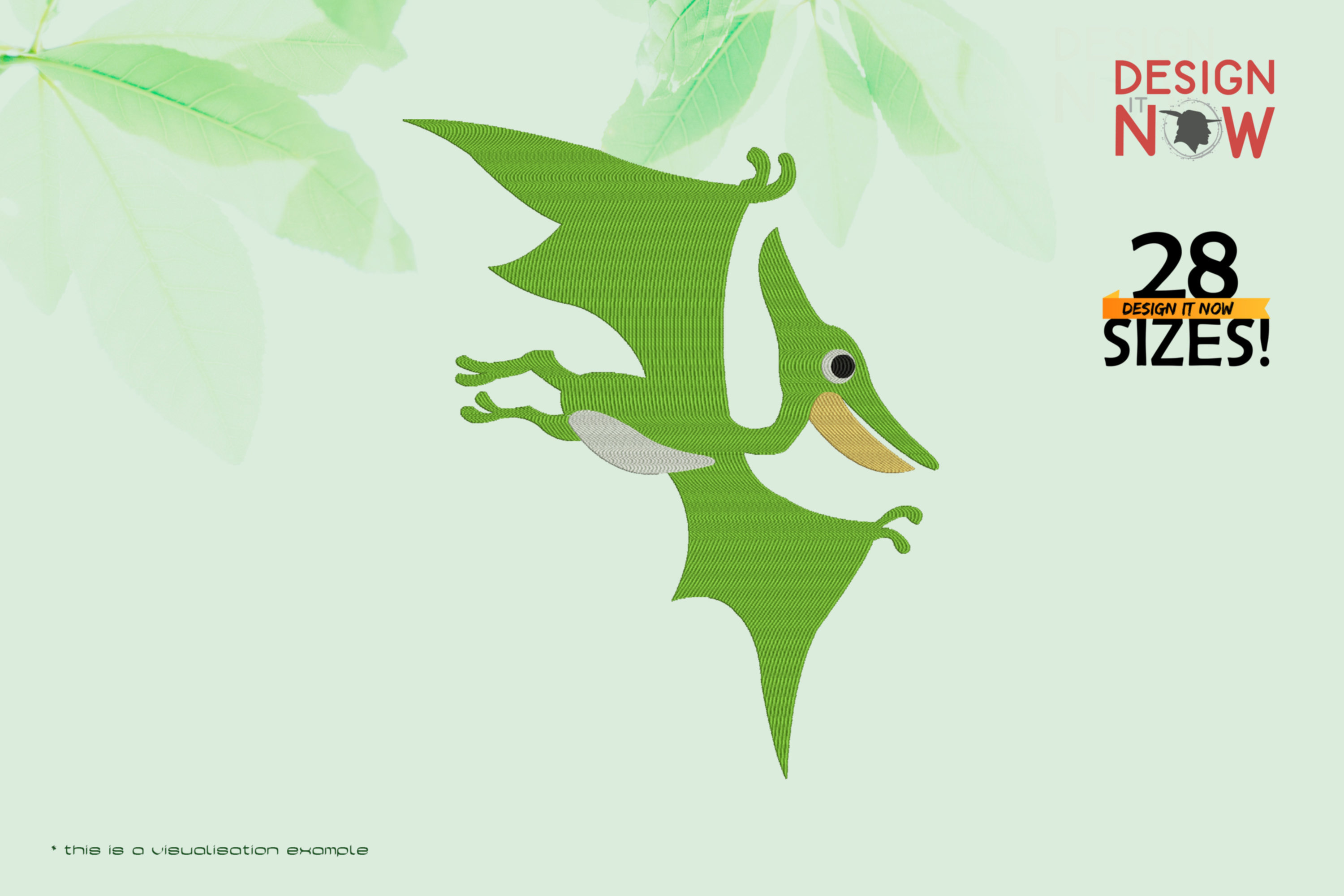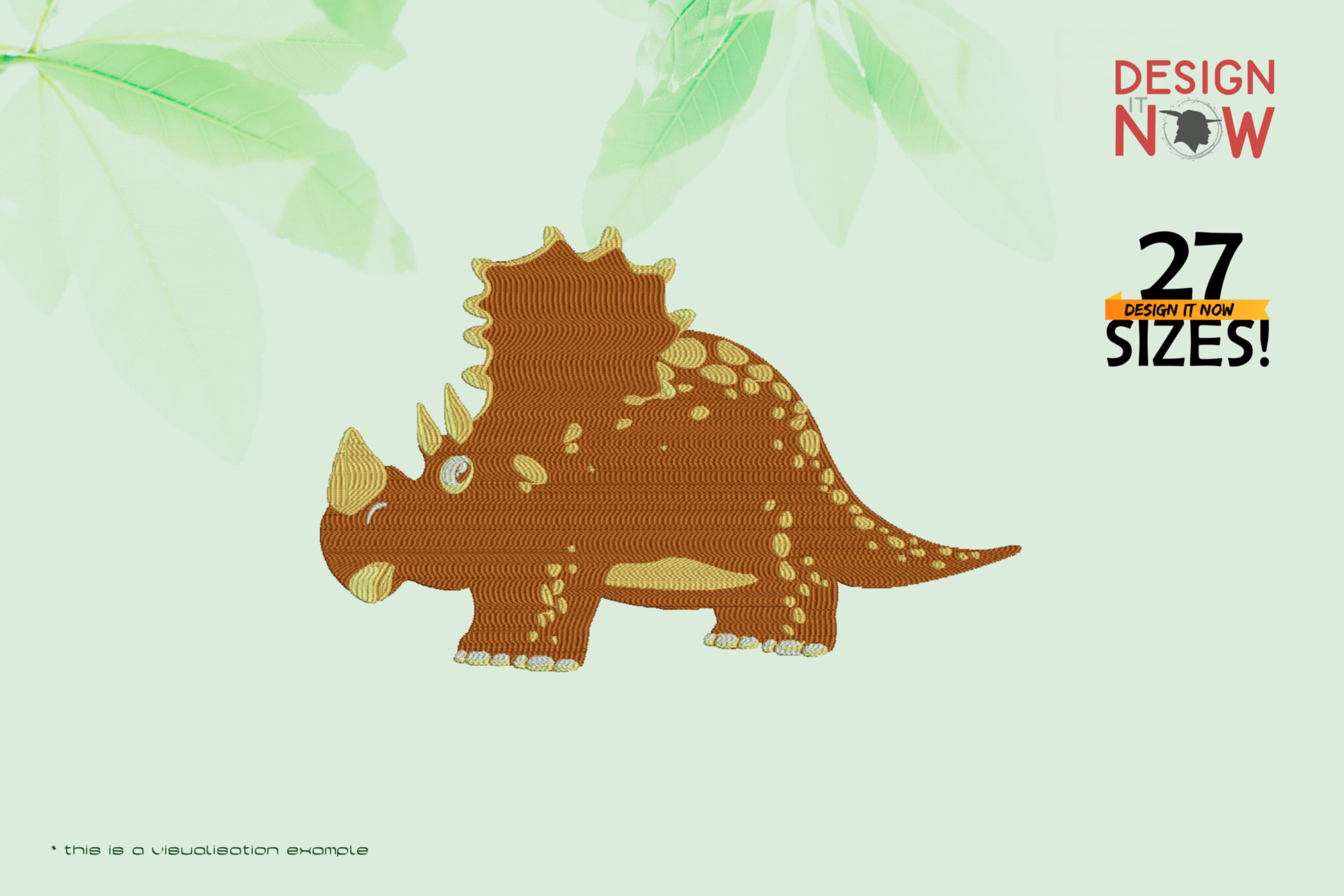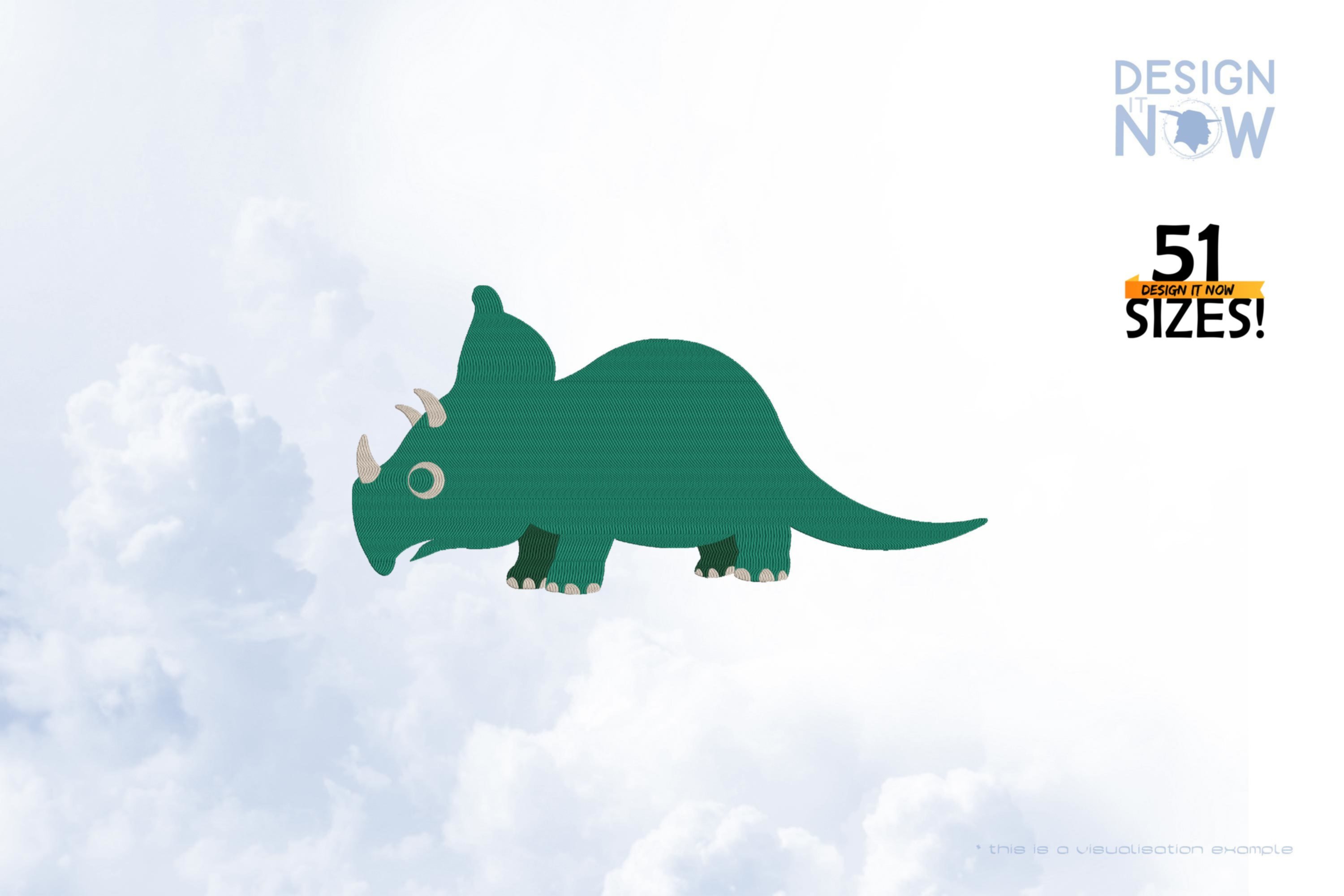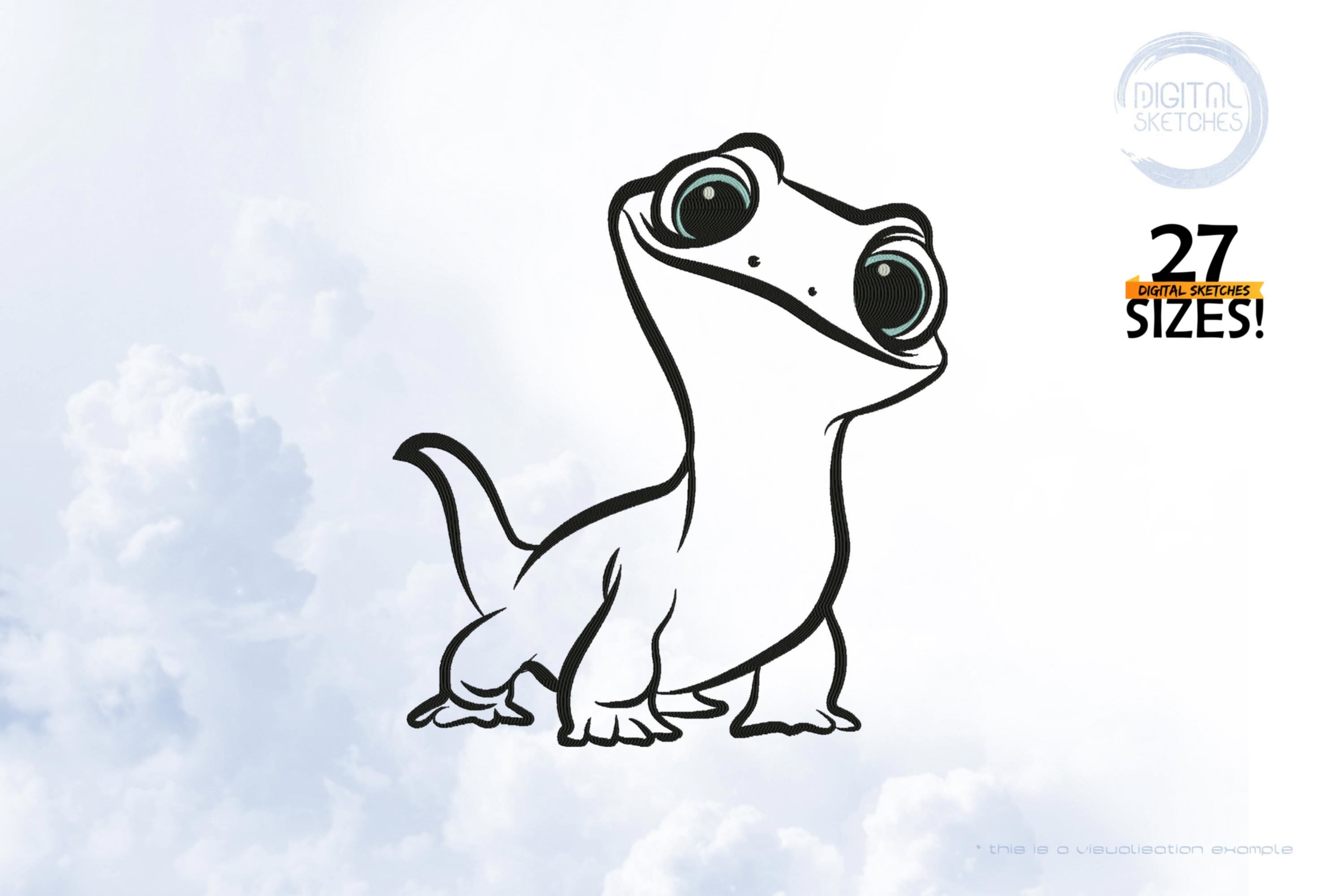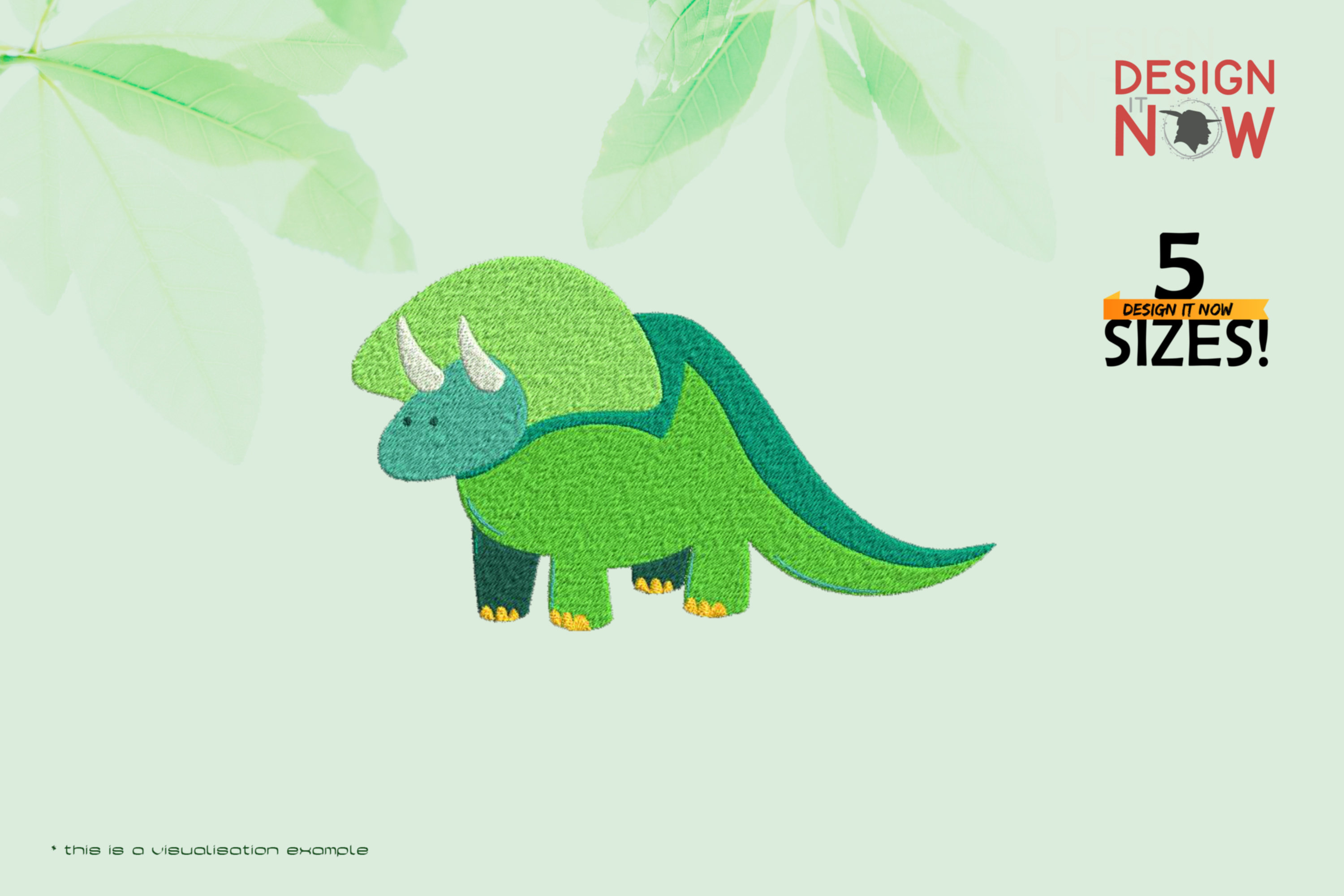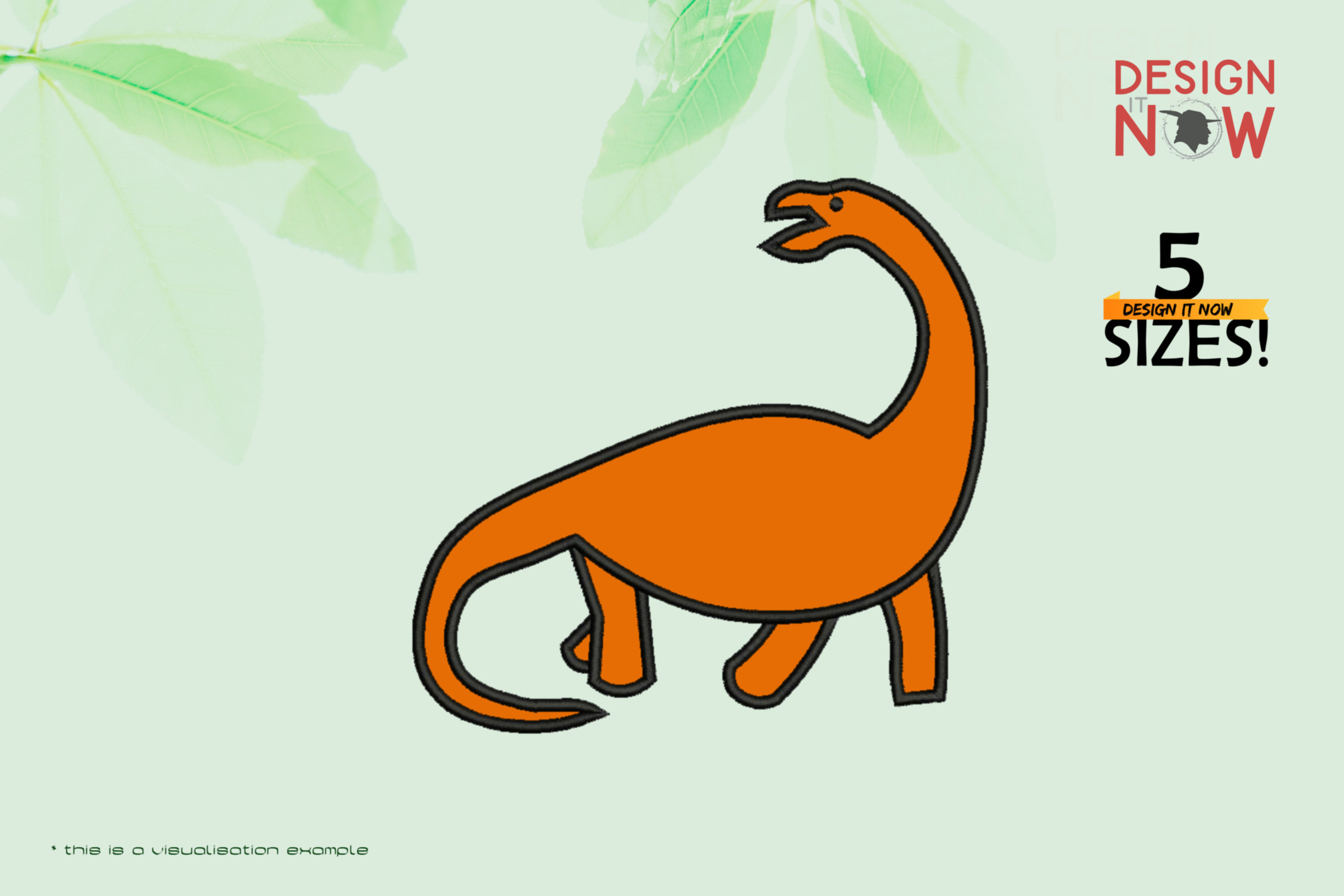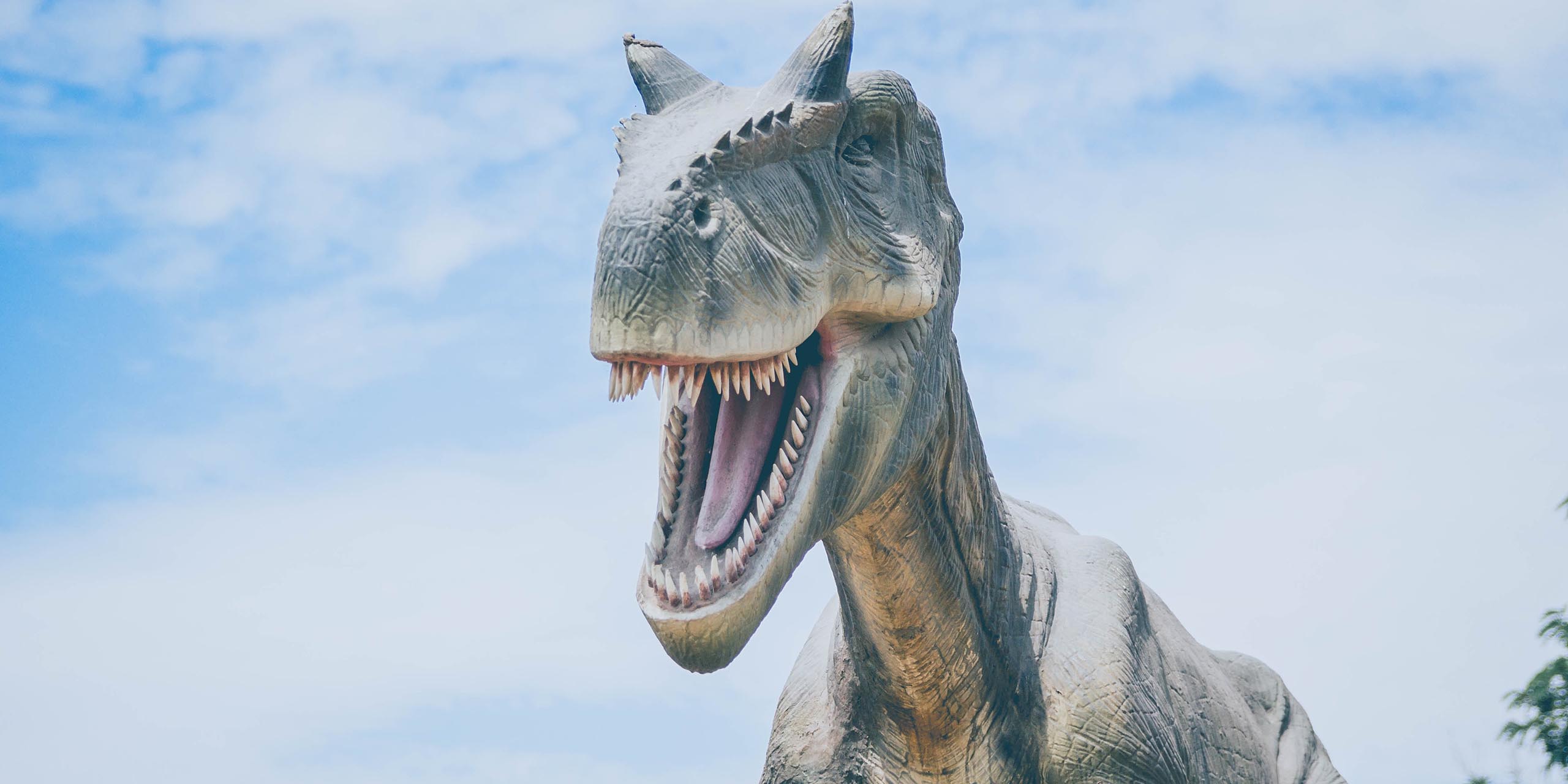
Dinosaurs
The dinosaurs (Dinosauria, from ancient Greek δεινός deinós, German 'terrible, formidable' and ancient Greek σαῦρος sauros, German 'lizard') are a group of terrestrial vertebrates that dominated continental ecosystems in the Earth's Middle Ages from the Upper Triassic about 235 million years ago to the Cretaceous-Paleogene boundary about 66 million years ago.
In classical systematics, dinosaurs are considered an extinct branch of reptiles, although they differ markedly in morphology from recent, or present-day, reptiles and are not particularly closely related to most recent reptiles, especially lizards and snakes.
From a cladistic point of view, which is the scientific standard today, both the sauropsids (sometimes alternatively referred to as reptiles altogether) and the dinosaurs include the birds that evolved from small theropod dinosaurs. Thus, not all dinosaurs became extinct during the mass extinction at the end of the Earth's Middle Ages, but with the birds a special evolutionary lineage of dinosaurs survived to the present day. This lineage proved to be extraordinarily adaptable and successful: birds make up about a third of all recent terrestrial vertebrate species, are represented in all terrestrial ecosystems, and also feature a group, the penguins, that is strongly adapted to life in and around water.
However, in zoology, which deals primarily with recent animals, and especially in ornithology, birds are still usually considered a class in their own right rather than dinosaurs or reptiles. The same is true in common usage. Even in modern vertebrate paleontology, an informal separation of birds and dinosaurs in the classical sense is common. The latter are also referred to as non-avian dinosaurs, in keeping with the cladistic view.
Knowledge of dinosaurs is obtained by paleontologists through the study of fossils, which have survived in the form of fossilized bones, skin and tissue impressions, and trace fossils, i.e. footprints, eggs, nests, stomach stones or fossilized feces. Dinosaur remains have been found on every continent, including Antarctica, because dinosaurs evolved at a time when the entire mainland was united in the supercontinent Pangaea.
In the first half of the 20th century, dinosaurs were considered to be cold-blooded, sluggish, and not very intelligent animals. However, numerous studies since the 1970s have shown that they were active animals with increased metabolic rates and adaptations that enabled social interactions.
- Machine Embroidery Designs
- Bags
- Printables
- Graphics
- Thread Color Mapping
- How-To's
Filter
–
%
Dinosaur X
The dinosaurs (Dinosauria, from Ancient Greek deinós, German 'terrible, formidable' and Ancient Greek sauros, German: lizard) are a group of terrestrial vertebrates that dominated continental ecosystems in the Earth's Middle Ages from the Upper Triassic about 235 million years ago to the Cretaceous-Paleogene boundary about 66 million years ago. In classical systematics, dinosaurs are considered an extinct branch of reptiles, although they differ markedly in morphology from recent, or present-day, reptiles and are not particularly closely related to most recent reptiles, especially lizards and snakes. From a cladistic point of view, which is the scientific standard today, both the sauropsids (sometimes alternatively referred to as reptiles altogether) and the dinosaurs include the birds that evolved from small theropod dinosaurs. Thus, not all dinosaurs became extinct during the mass extinction at the end of the Earth's Middle Ages, but with the birds a special evolutionary lineage of dinosaurs survived to the present day. This lineage proved to be extraordinarily adaptable and successful: birds make up about a third of all recent terrestrial vertebrate species, are represented in all terrestrial ecosystems, and also feature a group, the penguins, that is strongly adapted to life in and around water. However, in zoology, which deals primarily with recent animals, and especially in ornithology, birds are still usually considered a class in their own right rather than dinosaurs or reptiles. The same is true in common usage. Even in modern vertebrate paleontology, an informal separation of birds and dinosaurs in the classical sense is common. The latter are also referred to as non-avian dinosaurs, in keeping with the cladistic view. Knowledge of dinosaurs is obtained by paleontologists through the study of fossils, which have survived in the form of fossilized bones, skin and tissue impressions, and trace fossils, i.e. footprints, eggs, nests, stomach stones or fossilized feces. Dinosaur remains have been found on every continent, including Antarctica, because dinosaurs evolved at a time when the entire mainland was united in the supercontinent Pangaea. In the first half of the 20th century, dinosaurs were considered to be cold-blooded, sluggish, and not very intelligent animals. However, numerous studies since the 1970s have shown that they were active animals with increased metabolic rates and adaptations that enabled social interactions. Dinosaurs have become a part of global pop culture and feature in some extraordinarily successful books and movies.Product Number: N10986Product Name: dinosaur-2This design comes with the following sizes:Size: 5.20"(w) X 5.26"(h) (132.0mm X 133.6mm) Size: 5.31"(w) X 5.38"(h) (135.0mm X 136.6mm) Size: 5.34"(w) X 5.42"(h) (135.6mm X 137.6mm) Size: 5.46"(w) X 5.54"(h) (138.8mm X 140.6mm) Size: 5.69"(w) X 5.77"(h) (144.6mm X 146.6mm) Size: 5.73"(w) X 5.81"(h) (145.6mm X 147.6mm) Size: 5.81"(w) X 5.89"(h) (147.6mm X 149.6mm) Size: 5.90"(w) X 5.97"(h) (149.8mm X 151.6mm) Size: 5.96"(w) X 6.05"(h) (151.4mm X 153.6mm) Size: 6.01"(w) X 6.09"(h) (152.6mm X 154.6mm) Size: 6.28"(w) X 6.36"(h) (159.4mm X 161.6mm) Size: 6.39"(w) X 6.48"(h) (162.4mm X 164.6mm) Size: 6.43"(w) X 6.52"(h) (163.4mm X 165.6mm) Size: 6.54"(w) X 6.64"(h) (166.2mm X 168.6mm) Size: 6.63"(w) X 6.72"(h) (168.4mm X 170.6mm) Size: 6.67"(w) X 6.76"(h) (169.4mm X 171.6mm) Size: 6.70"(w) X 6.80"(h) (170.2mm X 172.6mm) Size: 6.79"(w) X 6.87"(h) (172.4mm X 174.6mm) Size: 6.86"(w) X 6.95"(h) (174.2mm X 176.6mm) Size: 6.90"(w) X 6.99"(h) (175.2mm X 177.6mm) Size: 6.96"(w) X 7.07"(h) (176.8mm X 179.6mm) Size: 7.10"(w) X 7.19"(h) (180.4mm X 182.6mm) Size: 7.14"(w) X 7.23"(h) (181.4mm X 183.6mm) Size: 7.17"(w) X 7.27"(h) (182.0mm X 184.6mm) Size: 7.60"(w) X 7.70"(h) (193.0mm X 195.6mm) Size: 7.75"(w) X 7.86"(h) (196.8mm X 199.6mm) Size: 7.87"(w) X 7.97"(h) (199.8mm X 202.4mm) Size: 7.91"(w) X 8.01"(h) (200.8mm X 203.4mm) Size: 8.03"(w) X 8.13"(h) (204.0mm X 206.6mm) Size: 8.22"(w) X 8.32"(h) (208.8mm X 211.4mm) Size: 8.26"(w) X 8.37"(h) (209.8mm X 212.6mm) Size: 8.69"(w) X 8.80"(h) (220.6mm X 223.6mm) Size: 8.72"(w) X 8.84"(h) (221.6mm X 224.6mm) Size: 8.80"(w) X 8.91"(h) (223.4mm X 226.4mm) Size: 8.84"(w) X 8.95"(h) (224.6mm X 227.4mm) Size: 8.95"(w) X 9.08"(h) (227.4mm X 230.6mm) Size: 9.07"(w) X 9.19"(h) (230.4mm X 233.4mm) Size: 9.38"(w) X 9.50"(h) (238.2mm X 241.4mm) Size: 9.55"(w) X 9.66"(h) (242.6mm X 245.4mm) Size: 9.69"(w) X 9.82"(h) (246.2mm X 249.4mm) Size: 9.82"(w) X 9.94"(h) (249.4mm X 252.4mm) Size: 9.90"(w) X 10.02"(h) (251.4mm X 254.4mm) Size: 10.20"(w) X 10.33"(h) (259.2mm X 262.4mm) Size: 10.28"(w) X 10.41"(h) (261.0mm X 264.4mm) Size: 10.48"(w) X 10.61"(h) (266.2mm X 269.4mm) Size: 10.52"(w) X 10.65"(h) (267.2mm X 270.4mm) Size: 10.71"(w) X 10.84"(h) (272.0mm X 275.4mm) Size: 10.78"(w) X 10.92"(h) (273.8mm X 277.4mm) Size: 11.05"(w) X 11.20"(h) (280.6mm X 284.4mm) Size: 11.18"(w) X 11.31"(h) (284.0mm X 287.4mm) Size: 12.57"(w) X 12.73"(h) (319.4mm X 323.4mm) Size: 12.72"(w) X 12.89"(h) (323.0mm X 327.4mm) Size: 12.80"(w) X 12.96"(h) (325.0mm X 329.2mm) Size: 13.96"(w) X 14.15"(h) (354.6mm X 359.4mm)The following formats are included in the file you will receive: .DST .EXP .JEF .PES .VP3 .XXX .PEC .U01You MUST have an embroidery machine and the software needed to transfer it from your computer to the machine to use this file. This listing is for the machine file only - not a finished item.Dinosaurs Machine Embroidery Design, Dinosauria Embroidery Pattern, Dinos Designs, Reptiles Embroidery Art, DIY Project Idea, Beautiful Digital Supplies For Embroidery Machines
US$1.10* US$4.40* (75% saved)
%
Dinosaur XI
The dinosaurs (Dinosauria, from Ancient Greek deinós, German 'terrible, formidable' and Ancient Greek sauros, German: lizard) are a group of terrestrial vertebrates that dominated continental ecosystems in the Earth's Middle Ages from the Upper Triassic about 235 million years ago to the Cretaceous-Paleogene boundary about 66 million years ago. In classical systematics, dinosaurs are considered an extinct branch of reptiles, although they differ markedly in morphology from recent, or present-day, reptiles and are not particularly closely related to most recent reptiles, especially lizards and snakes. From a cladistic point of view, which is the scientific standard today, both the sauropsids (sometimes alternatively referred to as reptiles altogether) and the dinosaurs include the birds that evolved from small theropod dinosaurs. Thus, not all dinosaurs became extinct during the mass extinction at the end of the Earth's Middle Ages, but with the birds a special evolutionary lineage of dinosaurs survived to the present day. This lineage proved to be extraordinarily adaptable and successful: birds make up about a third of all recent terrestrial vertebrate species, are represented in all terrestrial ecosystems, and also feature a group, the penguins, that is strongly adapted to life in and around water. However, in zoology, which deals primarily with recent animals, and especially in ornithology, birds are still usually considered a class in their own right rather than dinosaurs or reptiles. The same is true in common usage. Even in modern vertebrate paleontology, an informal separation of birds and dinosaurs in the classical sense is common. The latter are also referred to as non-avian dinosaurs, in keeping with the cladistic view. Knowledge of dinosaurs is obtained by paleontologists through the study of fossils, which have survived in the form of fossilized bones, skin and tissue impressions, and trace fossils, i.e. footprints, eggs, nests, stomach stones or fossilized feces. Dinosaur remains have been found on every continent, including Antarctica, because dinosaurs evolved at a time when the entire mainland was united in the supercontinent Pangaea. In the first half of the 20th century, dinosaurs were considered to be cold-blooded, sluggish, and not very intelligent animals. However, numerous studies since the 1970s have shown that they were active animals with increased metabolic rates and adaptations that enabled social interactions. Dinosaurs have become a part of global pop culture and feature in some extraordinarily successful books and movies.Product Number: N10985Product Name: dinosaur-3This design comes with the following sizes:Size: 2.43"(w) X 3.89"(h) (61.6mm X 98.8mm) Size: 3.06"(w) X 4.91"(h) (77.8mm X 124.8mm) Size: 3.09"(w) X 4.95"(h) (78.4mm X 125.8mm) Size: 3.11"(w) X 4.99"(h) (79.0mm X 126.8mm) Size: 3.13"(w) X 5.03"(h) (79.6mm X 127.8mm) Size: 3.24"(w) X 5.19"(h) (82.2mm X 131.8mm) Size: 3.26"(w) X 5.23"(h) (82.8mm X 132.8mm) Size: 3.28"(w) X 5.27"(h) (83.4mm X 133.8mm) Size: 3.31"(w) X 5.31"(h) (84.0mm X 134.8mm) Size: 3.41"(w) X 5.46"(h) (86.6mm X 138.8mm) Size: 3.83"(w) X 6.13"(h) (97.2mm X 155.8mm) Size: 3.85"(w) X 6.17"(h) (97.8mm X 156.8mm) Size: 3.87"(w) X 6.21"(h) (98.4mm X 157.8mm) Size: 3.94"(w) X 6.33"(h) (100.2mm X 160.8mm) Size: 4.05"(w) X 6.49"(h) (102.8mm X 164.8mm) Size: 4.07"(w) X 6.53"(h) (103.4mm X 165.8mm) Size: 4.09"(w) X 6.57"(h) (104.0mm X 166.8mm) Size: 4.14"(w) X 6.65"(h) (105.2mm X 168.8mm) Size: 4.24"(w) X 6.80"(h) (107.8mm X 172.8mm) Size: 4.29"(w) X 6.88"(h) (109.0mm X 174.8mm) Size: 4.41"(w) X 7.08"(h) (112.0mm X 179.8mm) Size: 4.44"(w) X 7.12"(h) (112.8mm X 180.8mm) Size: 4.46"(w) X 7.16"(h) (113.4mm X 181.8mm) Size: 4.51"(w) X 7.24"(h) (114.6mm X 183.8mm) Size: 4.71"(w) X 7.55"(h) (119.6mm X 191.8mm) Size: 4.78"(w) X 7.67"(h) (121.4mm X 194.8mm) Size: 4.83"(w) X 7.75"(h) (122.6mm X 196.8mm) Size: 4.86"(w) X 7.79"(h) (123.4mm X 197.8mm) Size: 4.91"(w) X 7.87"(h) (124.6mm X 199.8mm) Size: 4.95"(w) X 7.94"(h) (125.8mm X 201.8mm) Size: 5.02"(w) X 8.06"(h) (127.6mm X 204.8mm) Size: 5.05"(w) X 8.10"(h) (128.2mm X 205.8mm) Size: 5.15"(w) X 8.26"(h) (130.8mm X 209.8mm) Size: 5.24"(w) X 8.42"(h) (133.2mm X 213.8mm) Size: 5.37"(w) X 8.61"(h) (136.4mm X 218.8mm) Size: 5.39"(w) X 8.65"(h) (137.0mm X 219.8mm) Size: 5.44"(w) X 8.73"(h) (138.2mm X 221.8mm) Size: 6.01"(w) X 9.64"(h) (152.6mm X 244.8mm) Size: 6.13"(w) X 9.83"(h) (155.8mm X 249.8mm) Size: 6.20"(w) X 9.95"(h) (157.6mm X 252.8mm) Size: 6.89"(w) X 11.06"(h) (175.0mm X 280.8mm) Size: 6.99"(w) X 11.21"(h) (177.6mm X 284.8mm) Size: 7.36"(w) X 11.80"(h) (187.0mm X 299.8mm) Size: 7.78"(w) X 12.47"(h) (197.6mm X 316.8mm) Size: 7.85"(w) X 12.59"(h) (199.4mm X 319.8mm) Size: 8.73"(w) X 14.01"(h) (221.8mm X 355.8mm) Size: 9.82"(w) X 15.74"(h) (249.4mm X 399.8mm)The following formats are included in the file you will receive: .DST .EXP .JEF .PES .VP3 .XXX .PEC .U01You MUST have an embroidery machine and the software needed to transfer it from your computer to the machine to use this file. This listing is for the machine file only - not a finished item.Dinosaurs Machine Embroidery Design, Dinosauria Embroidery Pattern, Dinos Designs, Reptiles Embroidery Art, DIY Project Idea, Beautiful Digital Supplies For Embroidery Machines
US$1.10* US$4.40* (75% saved)
%
Dinosaur IX
The dinosaurs (Dinosauria, from Ancient Greek deinós, German 'terrible, formidable' and Ancient Greek sauros, German: lizard) are a group of terrestrial vertebrates that dominated continental ecosystems in the Earth's Middle Ages from the Upper Triassic about 235 million years ago to the Cretaceous-Paleogene boundary about 66 million years ago. In classical systematics, dinosaurs are considered an extinct branch of reptiles, although they differ markedly in morphology from recent, or present-day, reptiles and are not particularly closely related to most recent reptiles, especially lizards and snakes. From a cladistic point of view, which is the scientific standard today, both the sauropsids (sometimes alternatively referred to as reptiles altogether) and the dinosaurs include the birds that evolved from small theropod dinosaurs. Thus, not all dinosaurs became extinct during the mass extinction at the end of the Earth's Middle Ages, but with the birds a special evolutionary lineage of dinosaurs survived to the present day. This lineage proved to be extraordinarily adaptable and successful: birds make up about a third of all recent terrestrial vertebrate species, are represented in all terrestrial ecosystems, and also feature a group, the penguins, that is strongly adapted to life in and around water. However, in zoology, which deals primarily with recent animals, and especially in ornithology, birds are still usually considered a class in their own right rather than dinosaurs or reptiles. The same is true in common usage. Even in modern vertebrate paleontology, an informal separation of birds and dinosaurs in the classical sense is common. The latter are also referred to as non-avian dinosaurs, in keeping with the cladistic view. Knowledge of dinosaurs is obtained by paleontologists through the study of fossils, which have survived in the form of fossilized bones, skin and tissue impressions, and trace fossils, i.e. footprints, eggs, nests, stomach stones or fossilized feces. Dinosaur remains have been found on every continent, including Antarctica, because dinosaurs evolved at a time when the entire mainland was united in the supercontinent Pangaea. In the first half of the 20th century, dinosaurs were considered to be cold-blooded, sluggish, and not very intelligent animals. However, numerous studies since the 1970s have shown that they were active animals with increased metabolic rates and adaptations that enabled social interactions. Dinosaurs have become a part of global pop culture and feature in some extraordinarily successful books and movies.Product Number: N10983Product Name: dinosaur-1This design comes with the following sizes:Size: 4.94"(w) X 4.41"(h) (125.4mm X 112.0mm) Size: 5.14"(w) X 4.58"(h) (130.6mm X 116.4mm) Size: 5.26"(w) X 4.69"(h) (133.6mm X 119.0mm) Size: 5.40"(w) X 4.83"(h) (137.2mm X 122.6mm) Size: 5.46"(w) X 4.86"(h) (138.6mm X 123.4mm) Size: 5.47"(w) X 4.90"(h) (139.0mm X 124.4mm) Size: 5.53"(w) X 4.93"(h) (140.4mm X 125.2mm) Size: 5.75"(w) X 5.14"(h) (146.0mm X 130.6mm) Size: 5.87"(w) X 5.24"(h) (149.0mm X 133.2mm) Size: 6.14"(w) X 5.49"(h) (156.0mm X 139.4mm) Size: 6.19"(w) X 5.53"(h) (157.2mm X 140.4mm) Size: 6.43"(w) X 5.74"(h) (163.4mm X 145.8mm) Size: 6.48"(w) X 5.77"(h) (164.6mm X 146.6mm) Size: 6.51"(w) X 5.80"(h) (165.4mm X 147.4mm) Size: 6.56"(w) X 5.84"(h) (166.6mm X 148.4mm) Size: 6.77"(w) X 6.06"(h) (172.0mm X 153.8mm) Size: 6.92"(w) X 6.19"(h) (175.8mm X 157.2mm) Size: 7.34"(w) X 6.54"(h) (186.4mm X 166.2mm) Size: 7.85"(w) X 7.00"(h) (199.4mm X 177.8mm) Size: 8.08"(w) X 7.20"(h) (205.2mm X 183.0mm) Size: 8.13"(w) X 7.24"(h) (206.4mm X 184.0mm) Size: 8.24"(w) X 7.35"(h) (209.2mm X 186.6mm) Size: 8.75"(w) X 7.80"(h) (222.2mm X 198.2mm) Size: 8.79"(w) X 7.83"(h) (223.2mm X 199.0mm) Size: 9.28"(w) X 8.26"(h) (235.6mm X 209.8mm) Size: 10.91"(w) X 9.73"(h) (277.0mm X 247.2mm)The following formats are included in the file you will receive: .DST .EXP .JEF .PES .VP3 .XXX .PEC .U01You MUST have an embroidery machine and the software needed to transfer it from your computer to the machine to use this file. This listing is for the machine file only - not a finished item.Dinosaurs Machine Embroidery Design, Dinosauria Embroidery Pattern, Dinos Designs, Reptiles Embroidery Art, DIY Project Idea, Beautiful Digital Supplies For Embroidery Machines
US$1.10* US$4.40* (75% saved)
%
Rawrsome Dinosauria
The dinosaurs (Dinosauria, from Ancient Greek deinós, German 'terrible, formidable' and Ancient Greek sauros, German: lizard) are a group of terrestrial vertebrates that dominated continental ecosystems in the Earth's Middle Ages from the Upper Triassic about 235 million years ago to the Cretaceous-Paleogene boundary about 66 million years ago. In classical systematics, dinosaurs are considered an extinct branch of reptiles, although they differ markedly in morphology from recent, or present-day, reptiles and are not particularly closely related to most recent reptiles, especially lizards and snakes. From a cladistic point of view, which is the scientific standard today, both the sauropsids (sometimes alternatively referred to as reptiles altogether) and the dinosaurs include the birds that evolved from small theropod dinosaurs. Thus, not all dinosaurs became extinct during the mass extinction at the end of the Earth's Middle Ages, but with the birds a special evolutionary lineage of dinosaurs survived to the present day. This lineage proved to be extraordinarily adaptable and successful: birds make up about a third of all recent terrestrial vertebrate species, are represented in all terrestrial ecosystems, and also feature a group, the penguins, that is strongly adapted to life in and around water. However, in zoology, which deals primarily with recent animals, and especially in ornithology, birds are still usually considered a class in their own right rather than dinosaurs or reptiles. The same is true in common usage. Even in modern vertebrate paleontology, an informal separation of birds and dinosaurs in the classical sense is common. The latter are also referred to as non-avian dinosaurs, in keeping with the cladistic view. Knowledge of dinosaurs is obtained by paleontologists through the study of fossils, which have survived in the form of fossilized bones, skin and tissue impressions, and trace fossils, i.e. footprints, eggs, nests, stomach stones or fossilized feces. Dinosaur remains have been found on every continent, including Antarctica, because dinosaurs evolved at a time when the entire mainland was united in the supercontinent Pangaea. In the first half of the 20th century, dinosaurs were considered to be cold-blooded, sluggish, and not very intelligent animals. However, numerous studies since the 1970s have shown that they were active animals with increased metabolic rates and adaptations that enabled social interactions. Dinosaurs have become a part of global pop culture and feature in some extraordinarily successful books and movies.Product Number: N09116Product Name: rawrsomeThis design comes with the following sizes:Size: 7.71"(w) X 5.84"(h) (195.8mm X 148.4mm) Size: 7.83"(w) X 5.94"(h) (198.8mm X 150.8mm) Size: 7.87"(w) X 5.96"(h) (199.8mm X 151.4mm) Size: 7.91"(w) X 5.99"(h) (200.8mm X 152.2mm) Size: 8.30"(w) X 6.29"(h) (210.8mm X 159.8mm) Size: 8.46"(w) X 6.41"(h) (214.8mm X 162.8mm) Size: 8.54"(w) X 6.47"(h) (216.8mm X 164.4mm) Size: 8.61"(w) X 6.53"(h) (218.8mm X 165.8mm) Size: 8.65"(w) X 6.56"(h) (219.8mm X 166.6mm) Size: 8.77"(w) X 6.65"(h) (222.8mm X 169.0mm) Size: 8.97"(w) X 6.80"(h) (227.8mm X 172.8mm) Size: 9.20"(w) X 6.98"(h) (233.8mm X 177.2mm) Size: 9.40"(w) X 7.13"(h) (238.8mm X 181.0mm) Size: 9.44"(w) X 7.16"(h) (239.8mm X 181.8mm) Size: 9.83"(w) X 7.46"(h) (249.8mm X 189.4mm) Size: 10.23"(w) X 7.76"(h) (259.8mm X 197.0mm) Size: 10.35"(w) X 7.84"(h) (262.8mm X 199.2mm) Size: 13.77"(w) X 10.44"(h) (349.8mm X 265.2mm)The following formats are included in the file you will receive: .DST .EXP .JEF .PES .VP3 .XXX .PEC .U01You MUST have an embroidery machine and the software needed to transfer it from your computer to the machine to use this file. This listing is for the machine file only - not a finished item.Rawrsome Dinosaur Machine Embroidery Design, Dinosauria Embroidery Pattern, Dinos Designs, Reptiles Embroidery Art, DIY Project Idea, Beautiful Digital Supplies For Embroidery Machines
US$1.10* US$4.40* (75% saved)
%
Dinosaur VIII
The dinosaurs (Dinosauria, from Ancient Greek deinós, German 'terrible, formidable' and Ancient Greek sauros, German: lizard) are a group of terrestrial vertebrates that dominated continental ecosystems in the Earth's Middle Ages from the Upper Triassic about 235 million years ago to the Cretaceous-Paleogene boundary about 66 million years ago. In classical systematics, dinosaurs are considered an extinct branch of reptiles, although they differ markedly in morphology from recent, or present-day, reptiles and are not particularly closely related to most recent reptiles, especially lizards and snakes. From a cladistic point of view, which is the scientific standard today, both the sauropsids (sometimes alternatively referred to as reptiles altogether) and the dinosaurs include the birds that evolved from small theropod dinosaurs. Thus, not all dinosaurs became extinct during the mass extinction at the end of the Earth's Middle Ages, but with the birds a special evolutionary lineage of dinosaurs survived to the present day. This lineage proved to be extraordinarily adaptable and successful: birds make up about a third of all recent terrestrial vertebrate species, are represented in all terrestrial ecosystems, and also feature a group, the penguins, that is strongly adapted to life in and around water. However, in zoology, which deals primarily with recent animals, and especially in ornithology, birds are still usually considered a class in their own right rather than dinosaurs or reptiles. The same is true in common usage. Even in modern vertebrate paleontology, an informal separation of birds and dinosaurs in the classical sense is common. The latter are also referred to as non-avian dinosaurs, in keeping with the cladistic view. Knowledge of dinosaurs is obtained by paleontologists through the study of fossils, which have survived in the form of fossilized bones, skin and tissue impressions, and trace fossils, i.e. footprints, eggs, nests, stomach stones or fossilized feces. Dinosaur remains have been found on every continent, including Antarctica, because dinosaurs evolved at a time when the entire mainland was united in the supercontinent Pangaea. In the first half of the 20th century, dinosaurs were considered to be cold-blooded, sluggish, and not very intelligent animals. However, numerous studies since the 1970s have shown that they were active animals with increased metabolic rates and adaptations that enabled social interactions. Dinosaurs have become a part of global pop culture and feature in some extraordinarily successful books and movies.Product Number: N10669Product Name: Abstract-Dino-00001004This design comes with the following sizes:Size: 6.57"(w) X 3.19"(h) (166.8mm X 81.0mm) Size: 6.61"(w) X 3.20"(h) (167.8mm X 81.4mm) Size: 6.65"(w) X 3.23"(h) (168.8mm X 82.0mm) Size: 6.80"(w) X 3.30"(h) (172.8mm X 83.8mm) Size: 6.88"(w) X 3.33"(h) (174.8mm X 84.6mm) Size: 6.96"(w) X 3.37"(h) (176.8mm X 85.6mm) Size: 7.07"(w) X 3.43"(h) (179.6mm X 87.0mm) Size: 7.12"(w) X 3.45"(h) (180.8mm X 87.6mm) Size: 7.16"(w) X 3.46"(h) (181.8mm X 88.0mm) Size: 7.31"(w) X 3.54"(h) (185.8mm X 90.0mm) Size: 7.43"(w) X 3.60"(h) (188.6mm X 91.4mm) Size: 7.55"(w) X 3.67"(h) (191.8mm X 93.2mm) Size: 7.67"(w) X 3.72"(h) (194.8mm X 94.6mm) Size: 8.46"(w) X 4.11"(h) (214.8mm X 104.4mm) Size: 8.50"(w) X 4.12"(h) (215.8mm X 104.6mm) Size: 8.69"(w) X 4.21"(h) (220.6mm X 107.0mm) Size: 8.92"(w) X 4.34"(h) (226.6mm X 110.2mm) Size: 9.09"(w) X 4.42"(h) (230.8mm X 112.2mm) Size: 9.17"(w) X 4.46"(h) (232.8mm X 113.2mm) Size: 9.55"(w) X 4.64"(h) (242.6mm X 117.8mm) Size: 9.80"(w) X 4.76"(h) (248.8mm X 120.8mm) Size: 10.50"(w) X 5.10"(h) (266.6mm X 129.6mm) Size: 10.66"(w) X 5.17"(h) (270.8mm X 131.4mm) Size: 10.98"(w) X 5.33"(h) (278.8mm X 135.4mm) Size: 11.13"(w) X 5.40"(h) (282.6mm X 137.2mm) Size: 11.29"(w) X 5.49"(h) (286.8mm X 139.4mm) Size: 11.36"(w) X 5.53"(h) (288.6mm X 140.4mm) Size: 11.57"(w) X 5.62"(h) (293.8mm X 142.8mm) Size: 11.76"(w) X 5.72"(h) (298.8mm X 145.2mm) Size: 11.96"(w) X 5.81"(h) (303.8mm X 147.6mm) Size: 12.34"(w) X 6.00"(h) (313.4mm X 152.4mm) Size: 12.39"(w) X 6.02"(h) (314.6mm X 152.8mm) Size: 12.43"(w) X 6.04"(h) (315.8mm X 153.4mm) Size: 13.06"(w) X 6.35"(h) (331.8mm X 161.4mm)The following formats are included in the file you will receive: .DST .EXP .JEF .PES .VP3 .XXX .PEC .U01You MUST have an embroidery machine and the software needed to transfer it from your computer to the machine to use this file. This listing is for the machine file only - not a finished item.Children Dinosaur Machine Embroidery Design, Dinosauria Embroidery Pattern, Dinos Designs, Reptiles Embroidery Art, DIY Project Idea, Beautiful Digital Supplies For Embroidery Machines
US$1.10* US$4.40* (75% saved)
%
Dinosaur VII
The dinosaurs (Dinosauria, from Ancient Greek deinós, German 'terrible, formidable' and Ancient Greek sauros, German: lizard) are a group of terrestrial vertebrates that dominated continental ecosystems in the Earth's Middle Ages from the Upper Triassic about 235 million years ago to the Cretaceous-Paleogene boundary about 66 million years ago. In classical systematics, dinosaurs are considered an extinct branch of reptiles, although they differ markedly in morphology from recent, or present-day, reptiles and are not particularly closely related to most recent reptiles, especially lizards and snakes. From a cladistic point of view, which is the scientific standard today, both the sauropsids (sometimes alternatively referred to as reptiles altogether) and the dinosaurs include the birds that evolved from small theropod dinosaurs. Thus, not all dinosaurs became extinct during the mass extinction at the end of the Earth's Middle Ages, but with the birds a special evolutionary lineage of dinosaurs survived to the present day. This lineage proved to be extraordinarily adaptable and successful: birds make up about a third of all recent terrestrial vertebrate species, are represented in all terrestrial ecosystems, and also feature a group, the penguins, that is strongly adapted to life in and around water. However, in zoology, which deals primarily with recent animals, and especially in ornithology, birds are still usually considered a class in their own right rather than dinosaurs or reptiles. The same is true in common usage. Even in modern vertebrate paleontology, an informal separation of birds and dinosaurs in the classical sense is common. The latter are also referred to as non-avian dinosaurs, in keeping with the cladistic view. Knowledge of dinosaurs is obtained by paleontologists through the study of fossils, which have survived in the form of fossilized bones, skin and tissue impressions, and trace fossils, i.e. footprints, eggs, nests, stomach stones or fossilized feces. Dinosaur remains have been found on every continent, including Antarctica, because dinosaurs evolved at a time when the entire mainland was united in the supercontinent Pangaea. In the first half of the 20th century, dinosaurs were considered to be cold-blooded, sluggish, and not very intelligent animals. However, numerous studies since the 1970s have shown that they were active animals with increased metabolic rates and adaptations that enabled social interactions. Dinosaurs have become a part of global pop culture and feature in some extraordinarily successful books and movies.Product Number: N10682Product Name: Abstract-Dino-00001001This design comes with the following sizes:Size: 2.26"(w) X 3.65"(h) (57.4mm X 92.8mm) Size: 2.70"(w) X 4.36"(h) (68.6mm X 110.8mm) Size: 3.19"(w) X 5.15"(h) (81.0mm X 130.8mm) Size: 3.39"(w) X 5.46"(h) (86.0mm X 138.8mm) Size: 3.43"(w) X 5.54"(h) (87.2mm X 140.8mm) Size: 3.48"(w) X 5.62"(h) (88.4mm X 142.8mm) Size: 3.56"(w) X 5.74"(h) (90.4mm X 145.8mm) Size: 3.61"(w) X 5.82"(h) (91.6mm X 147.8mm) Size: 3.76"(w) X 6.06"(h) (95.4mm X 153.8mm) Size: 3.80"(w) X 6.13"(h) (96.6mm X 155.8mm) Size: 3.83"(w) X 6.17"(h) (97.2mm X 156.8mm) Size: 4.02"(w) X 6.49"(h) (102.2mm X 164.8mm) Size: 4.05"(w) X 6.53"(h) (102.8mm X 165.8mm) Size: 4.12"(w) X 6.65"(h) (104.6mm X 168.8mm) Size: 4.14"(w) X 6.69"(h) (105.2mm X 169.8mm) Size: 4.22"(w) X 6.80"(h) (107.2mm X 172.8mm) Size: 4.24"(w) X 6.84"(h) (107.8mm X 173.8mm) Size: 4.29"(w) X 6.92"(h) (109.0mm X 175.8mm) Size: 4.34"(w) X 7.00"(h) (110.2mm X 177.8mm) Size: 4.39"(w) X 7.08"(h) (111.4mm X 179.8mm) Size: 4.41"(w) X 7.12"(h) (112.0mm X 180.8mm) Size: 4.43"(w) X 7.16"(h) (112.6mm X 181.8mm) Size: 4.46"(w) X 7.20"(h) (113.4mm X 182.8mm) Size: 4.49"(w) X 7.24"(h) (114.0mm X 183.8mm) Size: 4.54"(w) X 7.31"(h) (115.2mm X 185.8mm) Size: 4.58"(w) X 7.39"(h) (116.4mm X 187.8mm) Size: 4.63"(w) X 7.47"(h) (117.6mm X 189.8mm) Size: 4.68"(w) X 7.55"(h) (118.8mm X 191.8mm) Size: 4.76"(w) X 7.67"(h) (120.8mm X 194.8mm) Size: 4.80"(w) X 7.75"(h) (122.0mm X 196.8mm) Size: 4.83"(w) X 7.79"(h) (122.6mm X 197.8mm) Size: 4.85"(w) X 7.83"(h) (123.2mm X 198.8mm) Size: 4.87"(w) X 7.87"(h) (123.8mm X 199.8mm) Size: 4.95"(w) X 7.98"(h) (125.8mm X 202.8mm) Size: 5.00"(w) X 8.06"(h) (127.0mm X 204.8mm) Size: 5.05"(w) X 8.14"(h) (128.2mm X 206.8mm) Size: 5.24"(w) X 8.46"(h) (133.2mm X 214.8mm) Size: 5.34"(w) X 8.61"(h) (135.6mm X 218.8mm) Size: 5.41"(w) X 8.73"(h) (137.4mm X 221.8mm) Size: 5.49"(w) X 8.85"(h) (139.4mm X 224.8mm) Size: 6.49"(w) X 10.46"(h) (164.8mm X 265.8mm) Size: 6.85"(w) X 11.06"(h) (174.0mm X 280.8mm) Size: 6.95"(w) X 11.21"(h) (176.6mm X 284.8mm) Size: 7.73"(w) X 12.47"(h) (196.4mm X 316.8mm) Size: 7.80"(w) X 12.59"(h) (198.2mm X 319.8mm) Size: 8.69"(w) X 14.01"(h) (220.6mm X 355.8mm) Size: 9.76"(w) X 15.74"(h) (248.0mm X 399.8mm)The following formats are included in the file you will receive: .DST .EXP .JEF .PES .VP3 .XXX .PEC .U01You MUST have an embroidery machine and the software needed to transfer it from your computer to the machine to use this file. This listing is for the machine file only - not a finished item.Dinosaur Silhouette Machine Embroidery Design, Dinosauria Embroidery Pattern, Dinos Designs, Reptiles Embroidery Art, DIY Project Idea, Beautiful Digital Supplies For Embroidery Machines
US$1.10* US$4.40* (75% saved)
%
Dinosaur V
The dinosaurs (Dinosauria, from Ancient Greek deinós, German 'terrible, formidable' and Ancient Greek sauros, German: lizard) are a group of terrestrial vertebrates that dominated continental ecosystems in the Earth's Middle Ages from the Upper Triassic about 235 million years ago to the Cretaceous-Paleogene boundary about 66 million years ago. In classical systematics, dinosaurs are considered an extinct branch of reptiles, although they differ markedly in morphology from recent, or present-day, reptiles and are not particularly closely related to most recent reptiles, especially lizards and snakes. From a cladistic point of view, which is the scientific standard today, both the sauropsids (sometimes alternatively referred to as reptiles altogether) and the dinosaurs include the birds that evolved from small theropod dinosaurs. Thus, not all dinosaurs became extinct during the mass extinction at the end of the Earth's Middle Ages, but with the birds a special evolutionary lineage of dinosaurs survived to the present day. This lineage proved to be extraordinarily adaptable and successful: birds make up about a third of all recent terrestrial vertebrate species, are represented in all terrestrial ecosystems, and also feature a group, the penguins, that is strongly adapted to life in and around water. However, in zoology, which deals primarily with recent animals, and especially in ornithology, birds are still usually considered a class in their own right rather than dinosaurs or reptiles. The same is true in common usage. Even in modern vertebrate paleontology, an informal separation of birds and dinosaurs in the classical sense is common. The latter are also referred to as non-avian dinosaurs, in keeping with the cladistic view. Knowledge of dinosaurs is obtained by paleontologists through the study of fossils, which have survived in the form of fossilized bones, skin and tissue impressions, and trace fossils, i.e. footprints, eggs, nests, stomach stones or fossilized feces. Dinosaur remains have been found on every continent, including Antarctica, because dinosaurs evolved at a time when the entire mainland was united in the supercontinent Pangaea. In the first half of the 20th century, dinosaurs were considered to be cold-blooded, sluggish, and not very intelligent animals. However, numerous studies since the 1970s have shown that they were active animals with increased metabolic rates and adaptations that enabled social interactions. Dinosaurs have become a part of global pop culture and feature in some extraordinarily successful books and movies.Product Number: N10684Product Name: Abstract-Dino-00001006This design comes with the following sizes:Size: 2.93"(w) X 3.60"(h) (74.4mm X 91.4mm) Size: 2.96"(w) X 3.65"(h) (75.2mm X 92.6mm) Size: 3.66"(w) X 4.51"(h) (93.0mm X 114.6mm) Size: 3.76"(w) X 4.63"(h) (95.4mm X 117.6mm) Size: 4.09"(w) X 5.02"(h) (103.8mm X 127.6mm) Size: 4.12"(w) X 5.06"(h) (104.6mm X 128.4mm) Size: 4.28"(w) X 5.25"(h) (108.6mm X 133.4mm) Size: 4.40"(w) X 5.42"(h) (111.8mm X 137.6mm) Size: 4.54"(w) X 5.57"(h) (115.2mm X 141.4mm) Size: 4.63"(w) X 5.69"(h) (117.6mm X 144.6mm) Size: 5.11"(w) X 6.28"(h) (129.8mm X 159.6mm) Size: 5.17"(w) X 6.35"(h) (131.4mm X 161.4mm) Size: 5.50"(w) X 6.76"(h) (139.6mm X 171.6mm) Size: 5.65"(w) X 6.94"(h) (143.6mm X 176.4mm) Size: 5.75"(w) X 7.07"(h) (146.0mm X 179.6mm) Size: 6.01"(w) X 7.38"(h) (152.6mm X 187.4mm) Size: 6.47"(w) X 7.98"(h) (164.4mm X 202.6mm) Size: 6.61"(w) X 8.13"(h) (167.8mm X 206.4mm) Size: 6.73"(w) X 8.29"(h) (171.0mm X 210.6mm) Size: 6.85"(w) X 8.45"(h) (174.0mm X 214.6mm) Size: 7.14"(w) X 8.80"(h) (181.4mm X 223.6mm) Size: 7.17"(w) X 8.84"(h) (182.2mm X 224.6mm) Size: 7.28"(w) X 8.95"(h) (184.8mm X 227.4mm) Size: 7.33"(w) X 9.03"(h) (186.2mm X 229.4mm) Size: 7.98"(w) X 9.82"(h) (202.6mm X 249.4mm) Size: 8.94"(w) X 11.01"(h) (227.0mm X 279.6mm) Size: 9.58"(w) X 11.80"(h) (243.4mm X 299.6mm) Size: 11.17"(w) X 13.76"(h) (283.6mm X 349.4mm)The following formats are included in the file you will receive: .DST .EXP .JEF .PES .VP3 .XXX .PEC .U01You MUST have an embroidery machine and the software needed to transfer it from your computer to the machine to use this file. This listing is for the machine file only - not a finished item.Dinosaur Bird Machine Embroidery Design, Dinosauria Embroidery Pattern, Dinos Designs, Reptiles Embroidery Art, DIY Project Idea, Beautiful Digital Supplies For Embroidery Machines
US$1.10* US$4.40* (75% saved)
%
Dinosaur VI
The dinosaurs (Dinosauria, from Ancient Greek deinós, German 'terrible, formidable' and Ancient Greek sauros, German: lizard) are a group of terrestrial vertebrates that dominated continental ecosystems in the Earth's Middle Ages from the Upper Triassic about 235 million years ago to the Cretaceous-Paleogene boundary about 66 million years ago. In classical systematics, dinosaurs are considered an extinct branch of reptiles, although they differ markedly in morphology from recent, or present-day, reptiles and are not particularly closely related to most recent reptiles, especially lizards and snakes. From a cladistic point of view, which is the scientific standard today, both the sauropsids (sometimes alternatively referred to as reptiles altogether) and the dinosaurs include the birds that evolved from small theropod dinosaurs. Thus, not all dinosaurs became extinct during the mass extinction at the end of the Earth's Middle Ages, but with the birds a special evolutionary lineage of dinosaurs survived to the present day. This lineage proved to be extraordinarily adaptable and successful: birds make up about a third of all recent terrestrial vertebrate species, are represented in all terrestrial ecosystems, and also feature a group, the penguins, that is strongly adapted to life in and around water. However, in zoology, which deals primarily with recent animals, and especially in ornithology, birds are still usually considered a class in their own right rather than dinosaurs or reptiles. The same is true in common usage. Even in modern vertebrate paleontology, an informal separation of birds and dinosaurs in the classical sense is common. The latter are also referred to as non-avian dinosaurs, in keeping with the cladistic view. Knowledge of dinosaurs is obtained by paleontologists through the study of fossils, which have survived in the form of fossilized bones, skin and tissue impressions, and trace fossils, i.e. footprints, eggs, nests, stomach stones or fossilized feces. Dinosaur remains have been found on every continent, including Antarctica, because dinosaurs evolved at a time when the entire mainland was united in the supercontinent Pangaea. In the first half of the 20th century, dinosaurs were considered to be cold-blooded, sluggish, and not very intelligent animals. However, numerous studies since the 1970s have shown that they were active animals with increased metabolic rates and adaptations that enabled social interactions. Dinosaurs have become a part of global pop culture and feature in some extraordinarily successful books and movies.Product Number: N10657Product Name: Abstract-Dino-00001002This design comes with the following sizes:Size: 5.78"(w) X 3.68"(h) (146.8mm X 93.4mm) Size: 5.86"(w) X 3.72"(h) (148.8mm X 94.6mm) Size: 5.93"(w) X 3.77"(h) (150.6mm X 95.8mm) Size: 6.17"(w) X 3.93"(h) (156.8mm X 99.8mm) Size: 6.24"(w) X 3.98"(h) (158.6mm X 101.0mm) Size: 6.29"(w) X 4.00"(h) (159.8mm X 101.6mm) Size: 6.44"(w) X 4.10"(h) (163.6mm X 104.2mm) Size: 6.56"(w) X 4.17"(h) (166.6mm X 106.0mm) Size: 6.65"(w) X 4.23"(h) (168.8mm X 107.4mm) Size: 6.76"(w) X 4.30"(h) (171.8mm X 109.2mm) Size: 6.96"(w) X 4.43"(h) (176.8mm X 112.4mm) Size: 7.04"(w) X 4.48"(h) (178.8mm X 113.8mm) Size: 7.08"(w) X 4.50"(h) (179.8mm X 114.4mm) Size: 7.16"(w) X 4.55"(h) (181.8mm X 115.6mm) Size: 7.23"(w) X 4.60"(h) (183.6mm X 116.8mm) Size: 7.28"(w) X 4.63"(h) (184.8mm X 117.6mm) Size: 7.51"(w) X 4.78"(h) (190.8mm X 121.4mm) Size: 7.66"(w) X 4.87"(h) (194.6mm X 123.8mm) Size: 7.83"(w) X 4.98"(h) (198.8mm X 126.4mm) Size: 7.86"(w) X 5.00"(h) (199.6mm X 127.0mm) Size: 8.61"(w) X 5.48"(h) (218.6mm X 139.2mm) Size: 8.92"(w) X 5.68"(h) (226.6mm X 144.2mm) Size: 9.09"(w) X 5.78"(h) (230.8mm X 146.8mm) Size: 9.79"(w) X 6.23"(h) (248.6mm X 158.2mm) Size: 9.91"(w) X 6.31"(h) (251.6mm X 160.2mm) Size: 10.22"(w) X 6.50"(h) (259.6mm X 165.2mm) Size: 10.42"(w) X 6.63"(h) (264.6mm X 168.4mm)The following formats are included in the file you will receive: .DST .EXP .JEF .PES .VP3 .XXX .PEC .U01You MUST have an embroidery machine and the software needed to transfer it from your computer to the machine to use this file. This listing is for the machine file only - not a finished item.Dinosaur Machine Embroidery Design, Dinosauria Embroidery Pattern, Dinos Designs, Reptiles Embroidery Art, DIY Project Idea, Beautiful Digital Supplies For Embroidery Machines
US$1.10* US$4.40* (75% saved)
%
Dinosaur IV
The dinosaurs (Dinosauria, from Ancient Greek deinós, German 'terrible, formidable' and Ancient Greek sauros, German: lizard) are a group of terrestrial vertebrates that dominated continental ecosystems in the Earth's Middle Ages from the Upper Triassic about 235 million years ago to the Cretaceous-Paleogene boundary about 66 million years ago. In classical systematics, dinosaurs are considered an extinct branch of reptiles, although they differ markedly in morphology from recent, or present-day, reptiles and are not particularly closely related to most recent reptiles, especially lizards and snakes. From a cladistic point of view, which is the scientific standard today, both the sauropsids (sometimes alternatively referred to as reptiles altogether) and the dinosaurs include the birds that evolved from small theropod dinosaurs. Thus, not all dinosaurs became extinct during the mass extinction at the end of the Earth's Middle Ages, but with the birds a special evolutionary lineage of dinosaurs survived to the present day. This lineage proved to be extraordinarily adaptable and successful: birds make up about a third of all recent terrestrial vertebrate species, are represented in all terrestrial ecosystems, and also feature a group, the penguins, that is strongly adapted to life in and around water. However, in zoology, which deals primarily with recent animals, and especially in ornithology, birds are still usually considered a class in their own right rather than dinosaurs or reptiles. The same is true in common usage. Even in modern vertebrate paleontology, an informal separation of birds and dinosaurs in the classical sense is common. The latter are also referred to as non-avian dinosaurs, in keeping with the cladistic view. Knowledge of dinosaurs is obtained by paleontologists through the study of fossils, which have survived in the form of fossilized bones, skin and tissue impressions, and trace fossils, i.e. footprints, eggs, nests, stomach stones or fossilized feces. Dinosaur remains have been found on every continent, including Antarctica, because dinosaurs evolved at a time when the entire mainland was united in the supercontinent Pangaea. In the first half of the 20th century, dinosaurs were considered to be cold-blooded, sluggish, and not very intelligent animals. However, numerous studies since the 1970s have shown that they were active animals with increased metabolic rates and adaptations that enabled social interactions. Dinosaurs have become a part of global pop culture and feature in some extraordinarily successful books and movies.Product Number: N10658Product Name: Abstract-Dino-00001005This design comes with the following sizes:Size: 6.09"(w) X 2.97"(h) (154.8mm X 75.4mm) Size: 6.21"(w) X 3.02"(h) (157.8mm X 76.6mm) Size: 6.57"(w) X 3.19"(h) (166.8mm X 81.0mm) Size: 6.69"(w) X 3.26"(h) (169.8mm X 82.8mm) Size: 6.76"(w) X 3.29"(h) (171.8mm X 83.6mm) Size: 6.88"(w) X 3.35"(h) (174.8mm X 85.0mm) Size: 6.92"(w) X 3.37"(h) (175.8mm X 85.6mm) Size: 6.96"(w) X 3.39"(h) (176.8mm X 86.2mm) Size: 7.08"(w) X 3.44"(h) (179.8mm X 87.4mm) Size: 7.16"(w) X 3.48"(h) (181.8mm X 88.4mm) Size: 7.28"(w) X 3.54"(h) (184.8mm X 90.0mm) Size: 7.31"(w) X 3.57"(h) (185.8mm X 90.6mm) Size: 7.55"(w) X 3.67"(h) (191.8mm X 93.2mm) Size: 7.59"(w) X 3.70"(h) (192.8mm X 94.0mm) Size: 7.83"(w) X 3.80"(h) (198.8mm X 96.6mm) Size: 7.94"(w) X 3.87"(h) (201.8mm X 98.2mm) Size: 8.10"(w) X 3.94"(h) (205.8mm X 100.0mm) Size: 8.30"(w) X 4.03"(h) (210.8mm X 102.4mm) Size: 8.46"(w) X 4.11"(h) (214.8mm X 104.4mm) Size: 9.05"(w) X 4.40"(h) (229.8mm X 111.8mm) Size: 9.17"(w) X 4.46"(h) (232.8mm X 113.2mm) Size: 9.20"(w) X 4.48"(h) (233.8mm X 113.8mm) Size: 9.24"(w) X 4.50"(h) (234.8mm X 114.2mm) Size: 9.44"(w) X 4.59"(h) (239.8mm X 116.6mm) Size: 9.52"(w) X 4.63"(h) (241.8mm X 117.6mm) Size: 9.56"(w) X 4.65"(h) (242.8mm X 118.0mm) Size: 9.83"(w) X 4.79"(h) (249.8mm X 121.6mm) Size: 9.95"(w) X 4.84"(h) (252.8mm X 123.0mm) Size: 10.35"(w) X 5.03"(h) (262.8mm X 127.8mm) Size: 10.50"(w) X 5.11"(h) (266.8mm X 129.8mm) Size: 10.66"(w) X 5.19"(h) (270.8mm X 131.8mm) Size: 11.06"(w) X 5.38"(h) (280.8mm X 136.6mm) Size: 11.21"(w) X 5.46"(h) (284.8mm X 138.6mm) Size: 11.57"(w) X 5.63"(h) (293.8mm X 143.0mm) Size: 11.76"(w) X 5.72"(h) (298.8mm X 145.4mm) Size: 11.96"(w) X 5.82"(h) (303.8mm X 147.8mm) Size: 12.35"(w) X 6.02"(h) (313.8mm X 152.8mm) Size: 12.59"(w) X 6.13"(h) (319.8mm X 155.6mm) Size: 12.71"(w) X 6.18"(h) (322.8mm X 157.0mm) Size: 13.38"(w) X 6.51"(h) (339.8mm X 165.4mm) Size: 13.54"(w) X 6.59"(h) (343.8mm X 167.4mm) Size: 14.01"(w) X 6.82"(h) (355.8mm X 173.2mm) Size: 14.17"(w) X 6.89"(h) (359.8mm X 175.0mm) Size: 14.24"(w) X 6.93"(h) (361.8mm X 176.0mm) Size: 14.83"(w) X 7.22"(h) (376.8mm X 183.4mm) Size: 15.07"(w) X 7.34"(h) (382.8mm X 186.4mm) Size: 15.23"(w) X 7.41"(h) (386.8mm X 188.2mm) Size: 15.39"(w) X 7.49"(h) (390.8mm X 190.2mm) Size: 15.74"(w) X 7.66"(h) (399.8mm X 194.6mm) Size: 16.92"(w) X 8.24"(h) (429.8mm X 209.2mm) Size: 17.71"(w) X 8.62"(h) (449.8mm X 219.0mm)The following formats are included in the file you will receive: .DST .EXP .JEF .PES .VP3 .XXX .PEC .U01You MUST have an embroidery machine and the software needed to transfer it from your computer to the machine to use this file. This listing is for the machine file only - not a finished item.Dinosaur Machine Embroidery Design, Dinosauria Embroidery Pattern, Dinos Designs, Reptiles Embroidery Art, DIY Project Idea, Beautiful Digital Supplies For Embroidery Machines
US$1.10* US$4.40* (75% saved)
%
Baby Dinosaur Sketch
The dinosaurs (Dinosauria, from Ancient Greek deinós, German 'terrible, formidable' and Ancient Greek sauros, German: lizard) are a group of terrestrial vertebrates that dominated continental ecosystems in the Earth's Middle Ages from the Upper Triassic about 235 million years ago to the Cretaceous-Paleogene boundary about 66 million years ago. In classical systematics, dinosaurs are considered an extinct branch of reptiles, although they differ markedly in morphology from recent, or present-day, reptiles and are not particularly closely related to most recent reptiles, especially lizards and snakes. From a cladistic point of view, which is the scientific standard today, both the sauropsids (sometimes alternatively referred to as reptiles altogether) and the dinosaurs include the birds that evolved from small theropod dinosaurs. Thus, not all dinosaurs became extinct during the mass extinction at the end of the Earth's Middle Ages, but with the birds a special evolutionary lineage of dinosaurs survived to the present day. This lineage proved to be extraordinarily adaptable and successful: birds make up about a third of all recent terrestrial vertebrate species, are represented in all terrestrial ecosystems, and also feature a group, the penguins, that is strongly adapted to life in and around water. However, in zoology, which deals primarily with recent animals, and especially in ornithology, birds are still usually considered a class in their own right rather than dinosaurs or reptiles. The same is true in common usage. Even in modern vertebrate paleontology, an informal separation of birds and dinosaurs in the classical sense is common. The latter are also referred to as non-avian dinosaurs, in keeping with the cladistic view. Knowledge of dinosaurs is obtained by paleontologists through the study of fossils, which have survived in the form of fossilized bones, skin and tissue impressions, and trace fossils, i.e. footprints, eggs, nests, stomach stones or fossilized feces. Dinosaur remains have been found on every continent, including Antarctica, because dinosaurs evolved at a time when the entire mainland was united in the supercontinent Pangaea. In the first half of the 20th century, dinosaurs were considered to be cold-blooded, sluggish, and not very intelligent animals. However, numerous studies since the 1970s have shown that they were active animals with increased metabolic rates and adaptations that enabled social interactions. Dinosaurs have become a part of global pop culture and feature in some extraordinarily successful books and movies.Product Number: N10456Product Name: babydino-sketchThis design comes with the following sizes:Size: 5.08"(w) X 5.62"(h) (129.0mm X 142.8mm) Size: 5.19"(w) X 5.74"(h) (131.8mm X 145.8mm) Size: 5.28"(w) X 5.86"(h) (134.2mm X 148.8mm) Size: 5.35"(w) X 5.94"(h) (136.0mm X 150.8mm) Size: 5.43"(w) X 6.02"(h) (137.8mm X 152.8mm) Size: 5.54"(w) X 6.13"(h) (140.6mm X 155.8mm) Size: 5.90"(w) X 6.53"(h) (149.8mm X 165.8mm) Size: 5.97"(w) X 6.61"(h) (151.6mm X 167.8mm) Size: 6.03"(w) X 6.69"(h) (153.2mm X 169.8mm) Size: 6.46"(w) X 7.16"(h) (164.0mm X 181.8mm) Size: 6.57"(w) X 7.28"(h) (166.8mm X 184.8mm) Size: 6.67"(w) X 7.39"(h) (169.4mm X 187.8mm) Size: 6.89"(w) X 7.63"(h) (175.0mm X 193.8mm) Size: 7.10"(w) X 7.87"(h) (180.4mm X 199.8mm) Size: 7.17"(w) X 7.94"(h) (182.2mm X 201.8mm) Size: 7.24"(w) X 8.02"(h) (184.0mm X 203.8mm) Size: 7.81"(w) X 8.65"(h) (198.4mm X 219.8mm) Size: 7.88"(w) X 8.73"(h) (200.2mm X 221.8mm) Size: 7.95"(w) X 8.81"(h) (202.0mm X 223.8mm) Size: 8.73"(w) X 9.68"(h) (221.8mm X 245.8mm) Size: 9.02"(w) X 9.99"(h) (229.2mm X 253.8mm) Size: 9.62"(w) X 10.66"(h) (244.4mm X 270.8mm) Size: 10.30"(w) X 11.41"(h) (261.6mm X 289.8mm) Size: 10.58"(w) X 11.72"(h) (268.8mm X 297.8mm) Size: 11.65"(w) X 12.91"(h) (296.0mm X 327.8mm) Size: 11.76"(w) X 13.02"(h) (298.6mm X 330.8mm) Size: 12.79"(w) X 14.17"(h) (324.8mm X 359.8mm)The following formats are included in the file you will receive: .DST .EXP .JEF .PES .VP3 .XXX .PEC .U01You MUST have an embroidery machine and the software needed to transfer it from your computer to the machine to use this file. This listing is for the machine file only - not a finished item.Baby Dinosaur Sketch Embroidery, Hand-Drawn Dinosaurs Machine Embroidery Design, Dinosauria Embroidery Pattern, Dinos Designs, Reptiles Embroidery Art, DIY Project Idea, Beautiful Digital Supplies For Embroidery Machines
US$1.10* US$4.40* (75% saved)
%
Dinosaur III
The dinosaurs (Dinosauria, from Ancient Greek deinós, German 'terrible, formidable' and Ancient Greek sauros, German: lizard) are a group of terrestrial vertebrates that dominated continental ecosystems in the Earth's Middle Ages from the Upper Triassic about 235 million years ago to the Cretaceous-Paleogene boundary about 66 million years ago. In classical systematics, dinosaurs are considered an extinct branch of reptiles, although they differ markedly in morphology from recent, or present-day, reptiles and are not particularly closely related to most recent reptiles, especially lizards and snakes. From a cladistic point of view, which is the scientific standard today, both the sauropsids (sometimes alternatively referred to as reptiles altogether) and the dinosaurs include the birds that evolved from small theropod dinosaurs. Thus, not all dinosaurs became extinct during the mass extinction at the end of the Earth's Middle Ages, but with the birds a special evolutionary lineage of dinosaurs survived to the present day. This lineage proved to be extraordinarily adaptable and successful: birds make up about a third of all recent terrestrial vertebrate species, are represented in all terrestrial ecosystems, and also feature a group, the penguins, that is strongly adapted to life in and around water. However, in zoology, which deals primarily with recent animals, and especially in ornithology, birds are still usually considered a class in their own right rather than dinosaurs or reptiles. The same is true in common usage. Even in modern vertebrate paleontology, an informal separation of birds and dinosaurs in the classical sense is common. The latter are also referred to as non-avian dinosaurs, in keeping with the cladistic view. Knowledge of dinosaurs is obtained by paleontologists through the study of fossils, which have survived in the form of fossilized bones, skin and tissue impressions, and trace fossils, i.e. footprints, eggs, nests, stomach stones or fossilized feces. Dinosaur remains have been found on every continent, including Antarctica, because dinosaurs evolved at a time when the entire mainland was united in the supercontinent Pangaea. In the first half of the 20th century, dinosaurs were considered to be cold-blooded, sluggish, and not very intelligent animals. However, numerous studies since the 1970s have shown that they were active animals with increased metabolic rates and adaptations that enabled social interactions. Dinosaurs have become a part of global pop culture and feature in some extraordinarily successful books and movies.Product Number: N03827Product Name: DinoThis design comes with the following sizes:Size: 3.94"(w) X 2.30"(h) (100.2 X 58.5mm) Size: 4.73"(w) X 2.76"(h) (120.2 X 70.1mm) Size: 5.52"(w) X 3.22"(h) (140.2 X 81.7mm) Size: 6.70"(w) X 3.90"(h) (170.2 X 99.1mm) Size: 7.84"(w) X 4.56"(h) (199.2 X 115.9mm)The following formats are included in the file you will receive: .DST .EXP .JEF .PES .VP3 .XXX .VIP .HUSYou MUST have an embroidery machine and the software needed to transfer it from your computer to the machine to use this file. This listing is for the machine file only - not a finished item.Dinosaur Machine Embroidery Design, Dinosauria Embroidery Pattern, Dinos Designs, Reptiles Embroidery Art, DIY Project Idea, Beautiful Digital Supplies For Embroidery Machines
US$1.10* US$4.40* (75% saved)
%
Dinosaur Applique IV
The dinosaurs (Dinosauria, from Ancient Greek deinós, German 'terrible, formidable' and Ancient Greek sauros, German: lizard) are a group of terrestrial vertebrates that dominated continental ecosystems in the Earth's Middle Ages from the Upper Triassic about 235 million years ago to the Cretaceous-Paleogene boundary about 66 million years ago. In classical systematics, dinosaurs are considered an extinct branch of reptiles, although they differ markedly in morphology from recent, or present-day, reptiles and are not particularly closely related to most recent reptiles, especially lizards and snakes. From a cladistic point of view, which is the scientific standard today, both the sauropsids (sometimes alternatively referred to as reptiles altogether) and the dinosaurs include the birds that evolved from small theropod dinosaurs. Thus, not all dinosaurs became extinct during the mass extinction at the end of the Earth's Middle Ages, but with the birds a special evolutionary lineage of dinosaurs survived to the present day. This lineage proved to be extraordinarily adaptable and successful: birds make up about a third of all recent terrestrial vertebrate species, are represented in all terrestrial ecosystems, and also feature a group, the penguins, that is strongly adapted to life in and around water. However, in zoology, which deals primarily with recent animals, and especially in ornithology, birds are still usually considered a class in their own right rather than dinosaurs or reptiles. The same is true in common usage. Even in modern vertebrate paleontology, an informal separation of birds and dinosaurs in the classical sense is common. The latter are also referred to as non-avian dinosaurs, in keeping with the cladistic view. Knowledge of dinosaurs is obtained by paleontologists through the study of fossils, which have survived in the form of fossilized bones, skin and tissue impressions, and trace fossils, i.e. footprints, eggs, nests, stomach stones or fossilized feces. Dinosaur remains have been found on every continent, including Antarctica, because dinosaurs evolved at a time when the entire mainland was united in the supercontinent Pangaea. In the first half of the 20th century, dinosaurs were considered to be cold-blooded, sluggish, and not very intelligent animals. However, numerous studies since the 1970s have shown that they were active animals with increased metabolic rates and adaptations that enabled social interactions. Dinosaurs have become a part of global pop culture and feature in some extraordinarily successful books and movies.Product Number: A00087Product Name: DinoThis design comes with the following sizes:Size: 3.95"(w) X 3.81"(h) (100.3 X 96.8mm) Size: 4.74"(w) X 4.57"(h) (120.3 X 116.1mm) Size: 5.52"(w) X 5.33"(h) (140.3 X 135.4mm) Size: 6.70"(w) X 6.47"(h) (170.3 X 164.4mm) Size: 7.80"(w) X 7.54"(h) (198.2 X 191.4mm)The following formats are included in the file you will receive: .DST .EXP .JEF .PES .VP3 .XXX .HUS .VIPYou MUST have an embroidery machine and the software needed to transfer it from your computer to the machine to use this file. This listing is for the machine file only - not a finished item.Dinosaur Applique Machine Embroidery Design, Dinosauria Embroidery Pattern, Dinos Designs, Reptiles Embroidery Art, DIY Project Idea, Beautiful Digital Supplies For Embroidery Machines
US$1.10* US$4.40* (75% saved)


